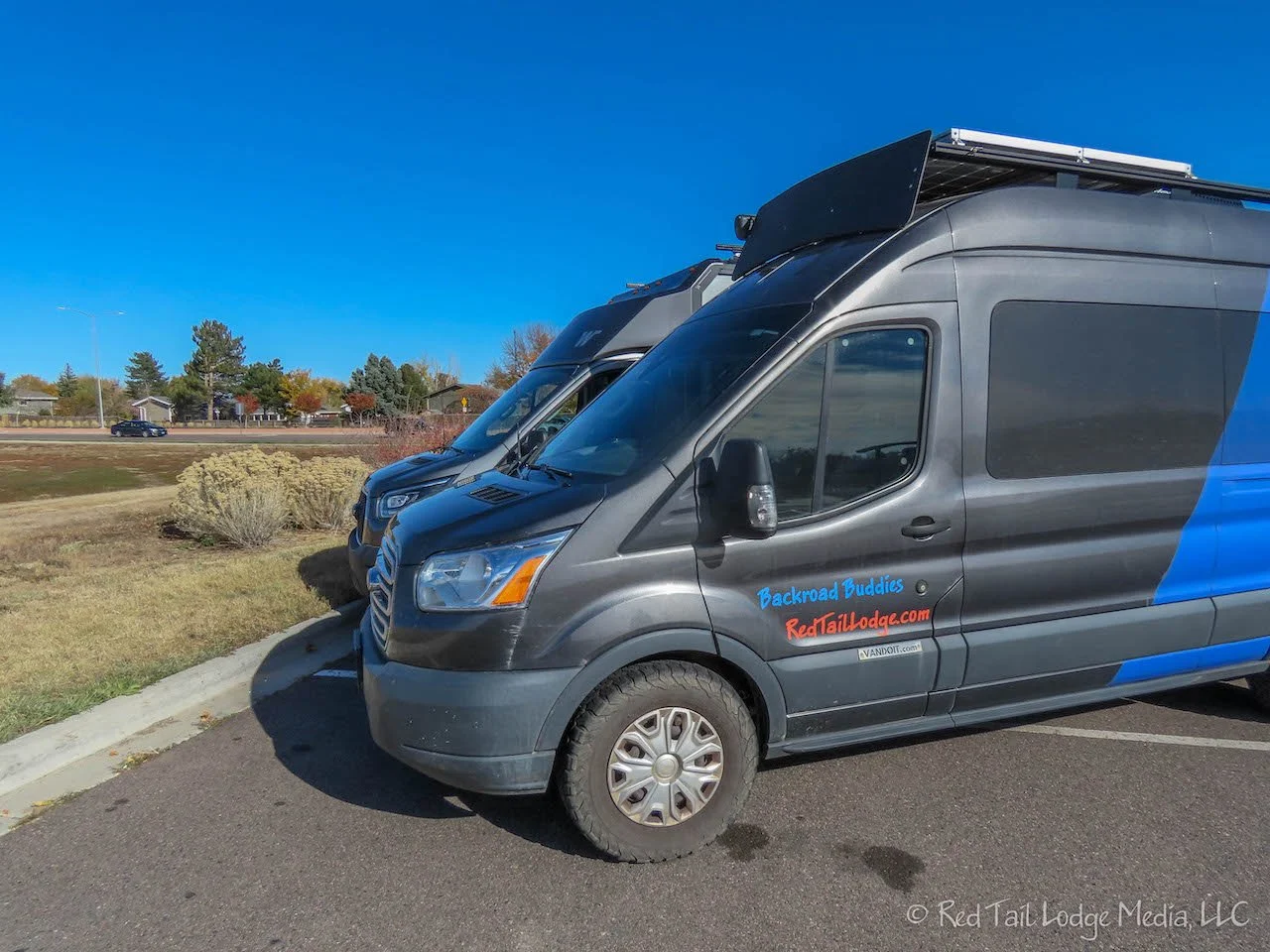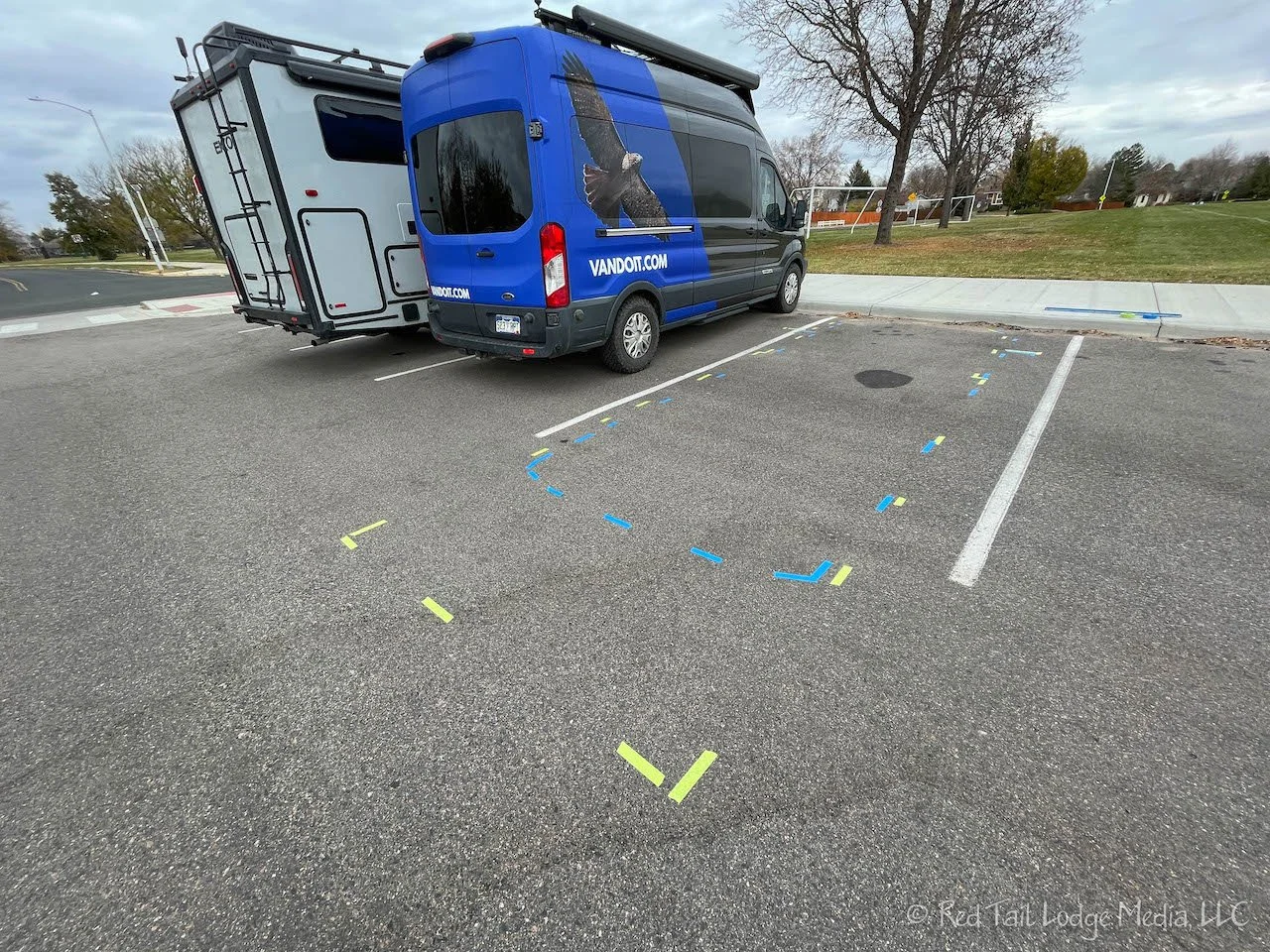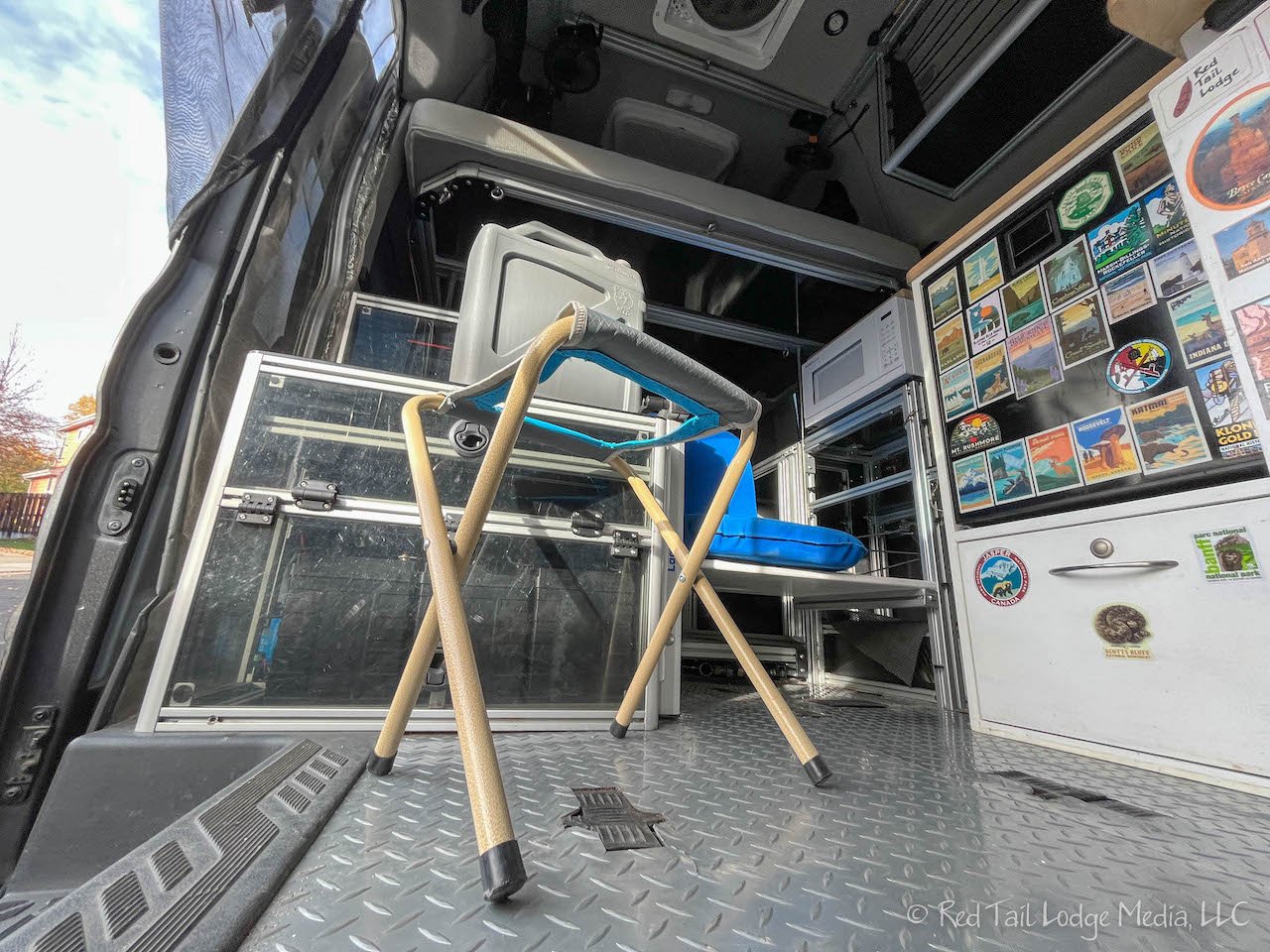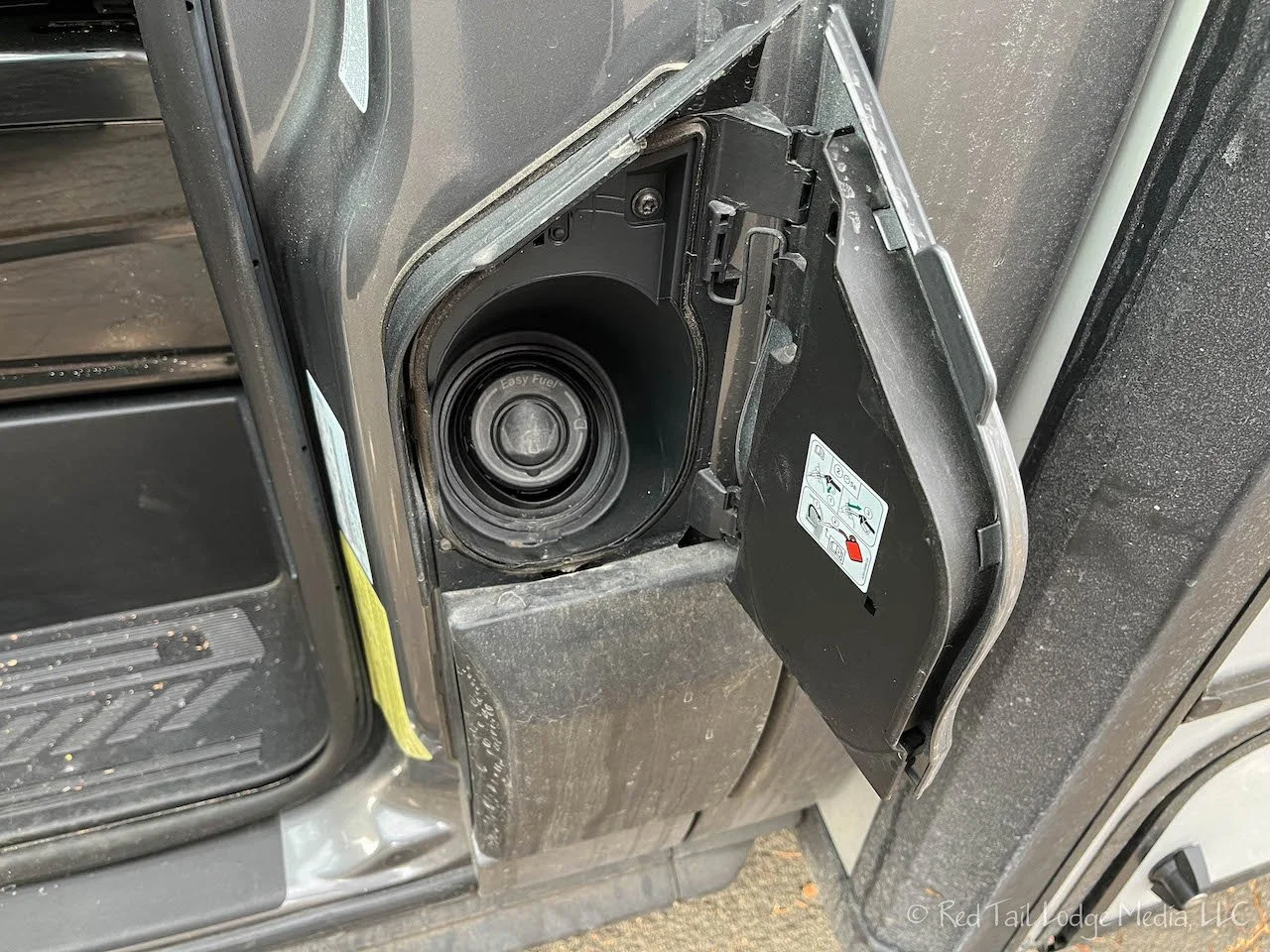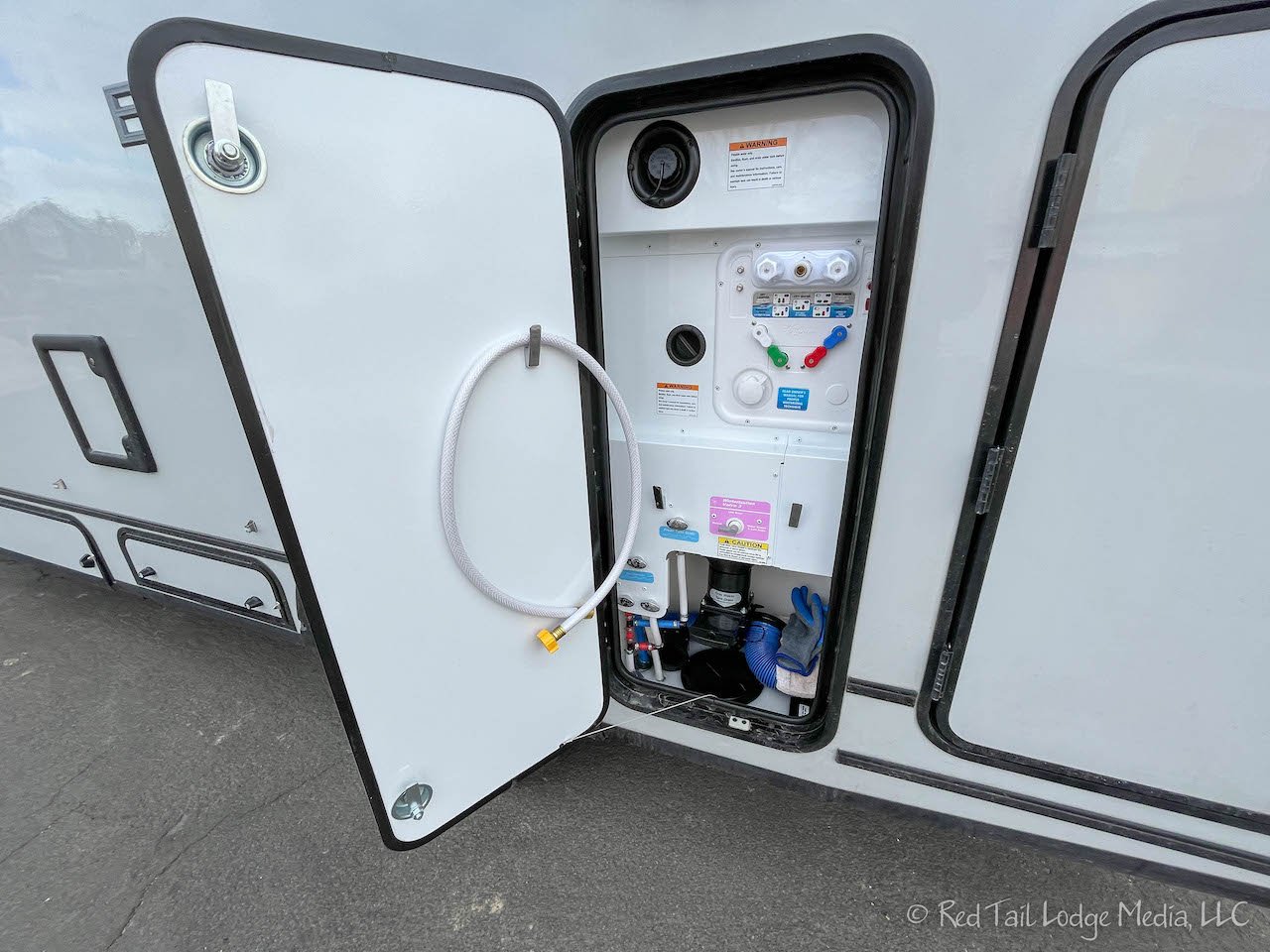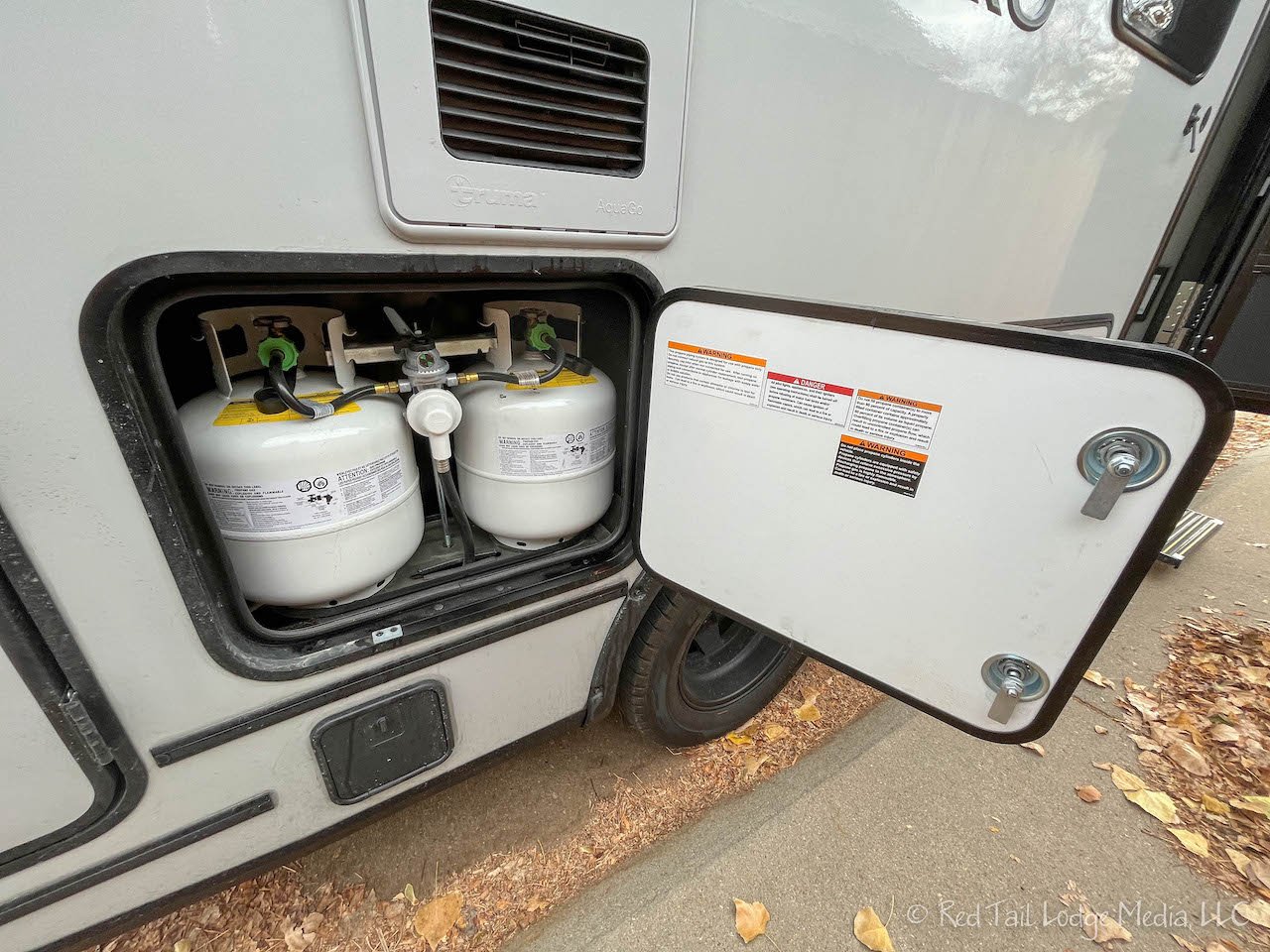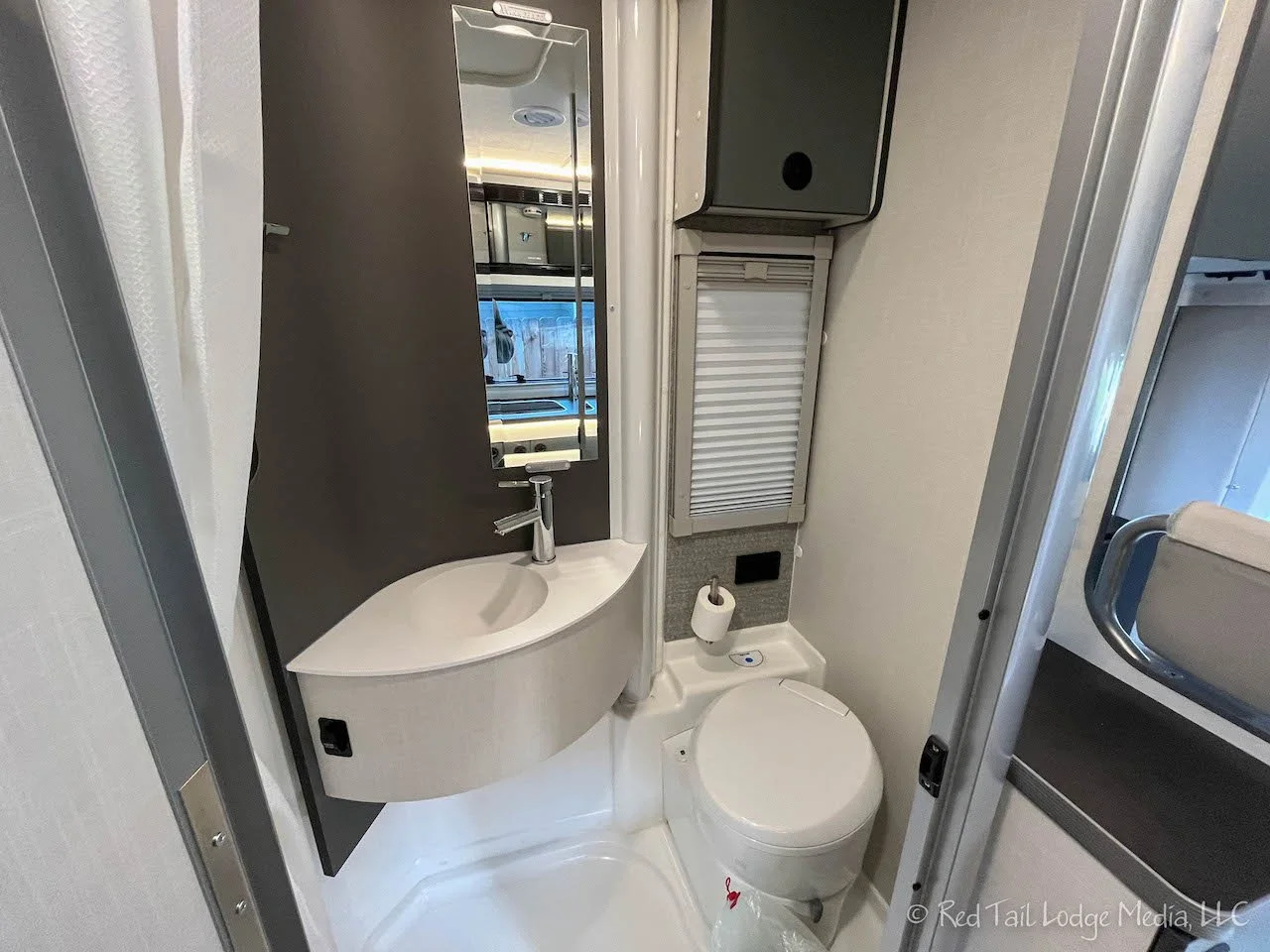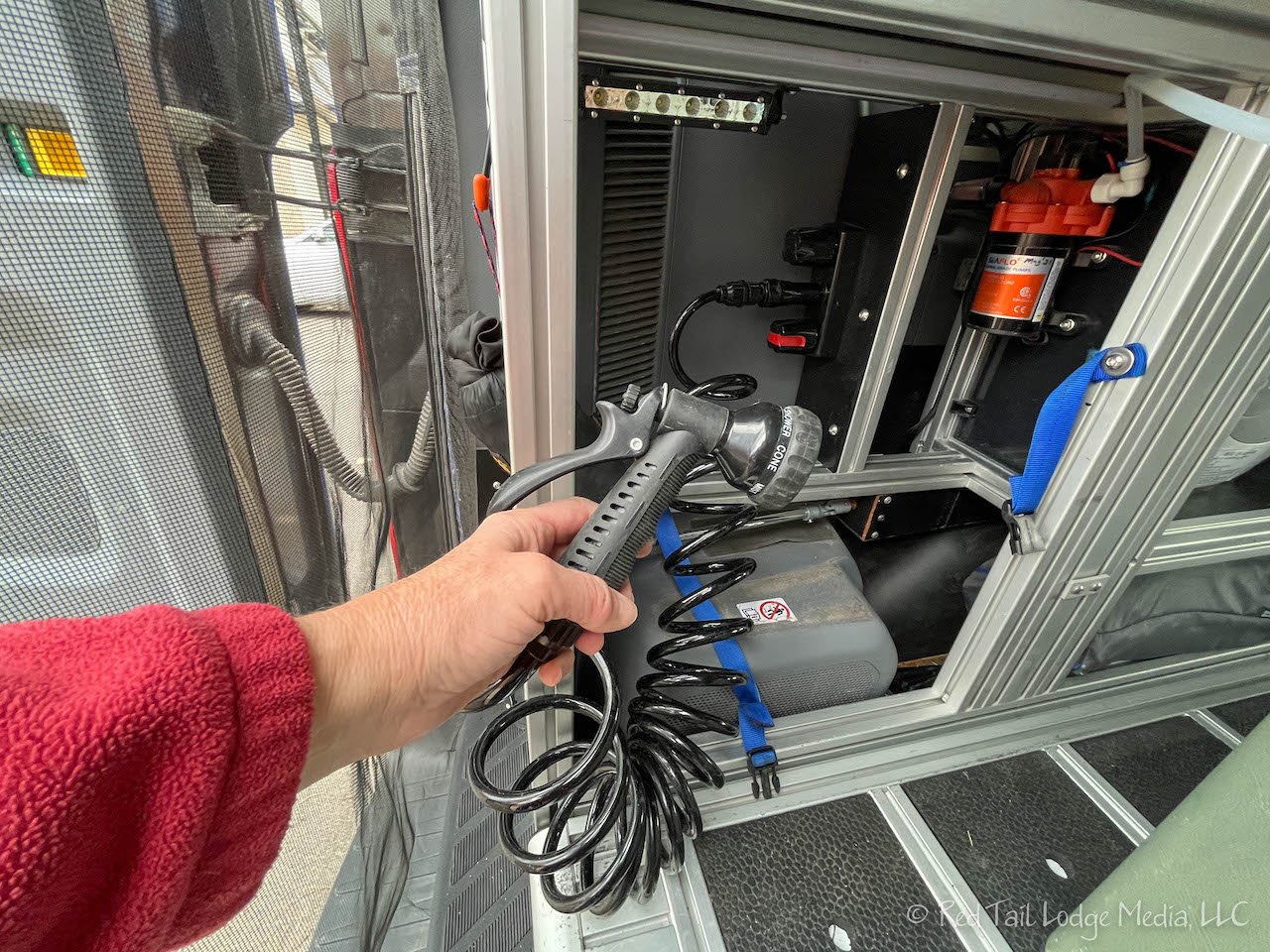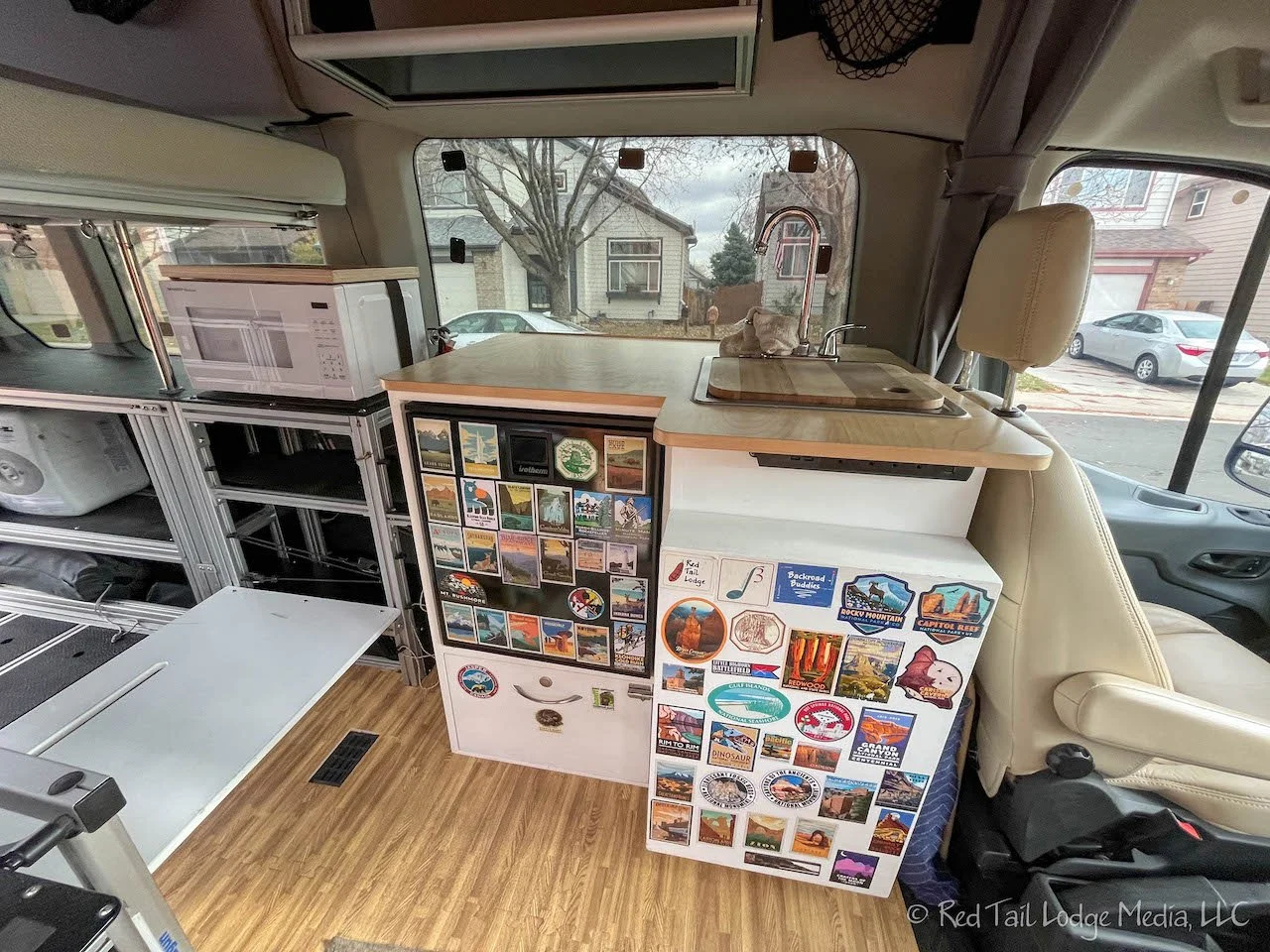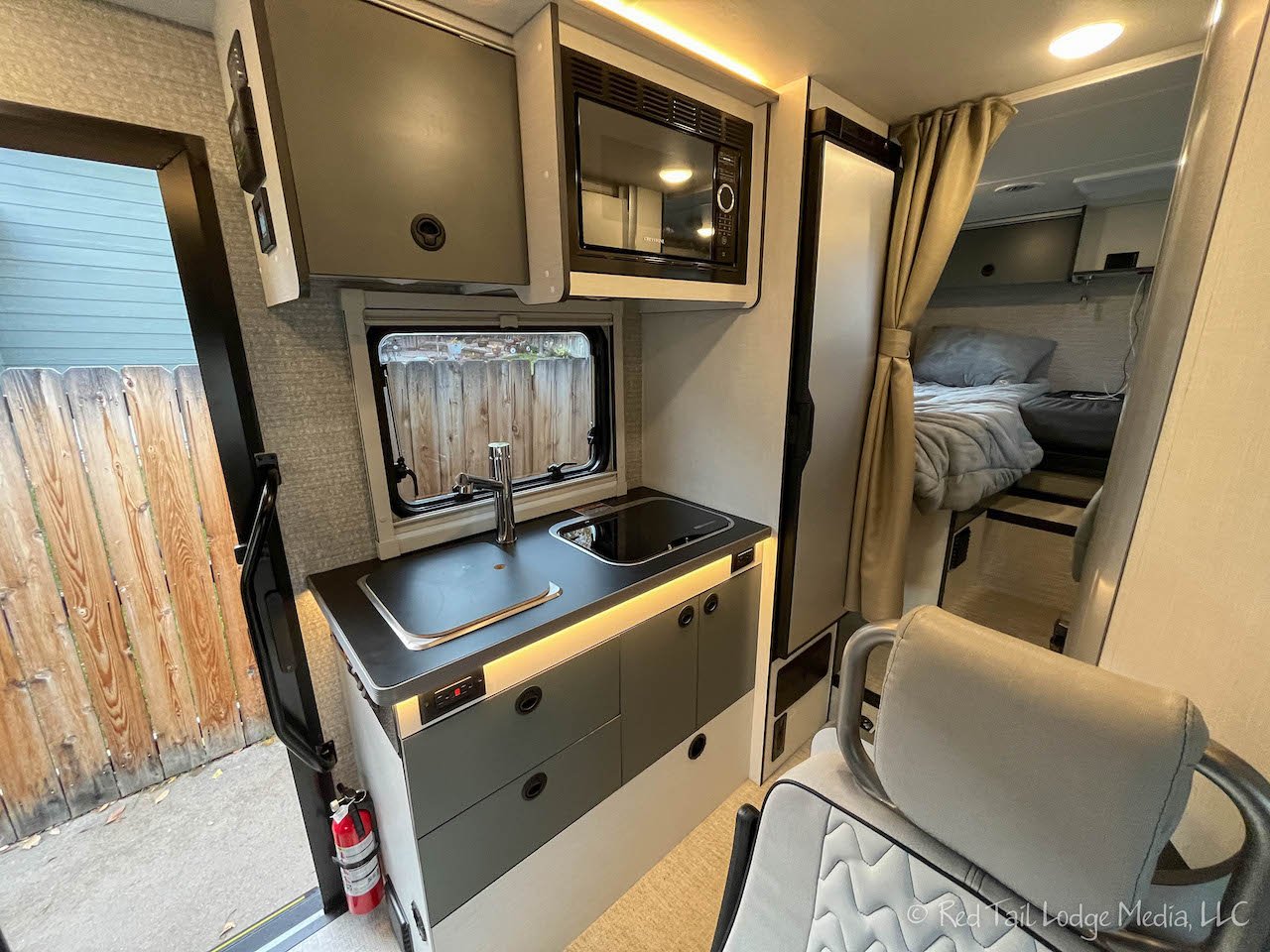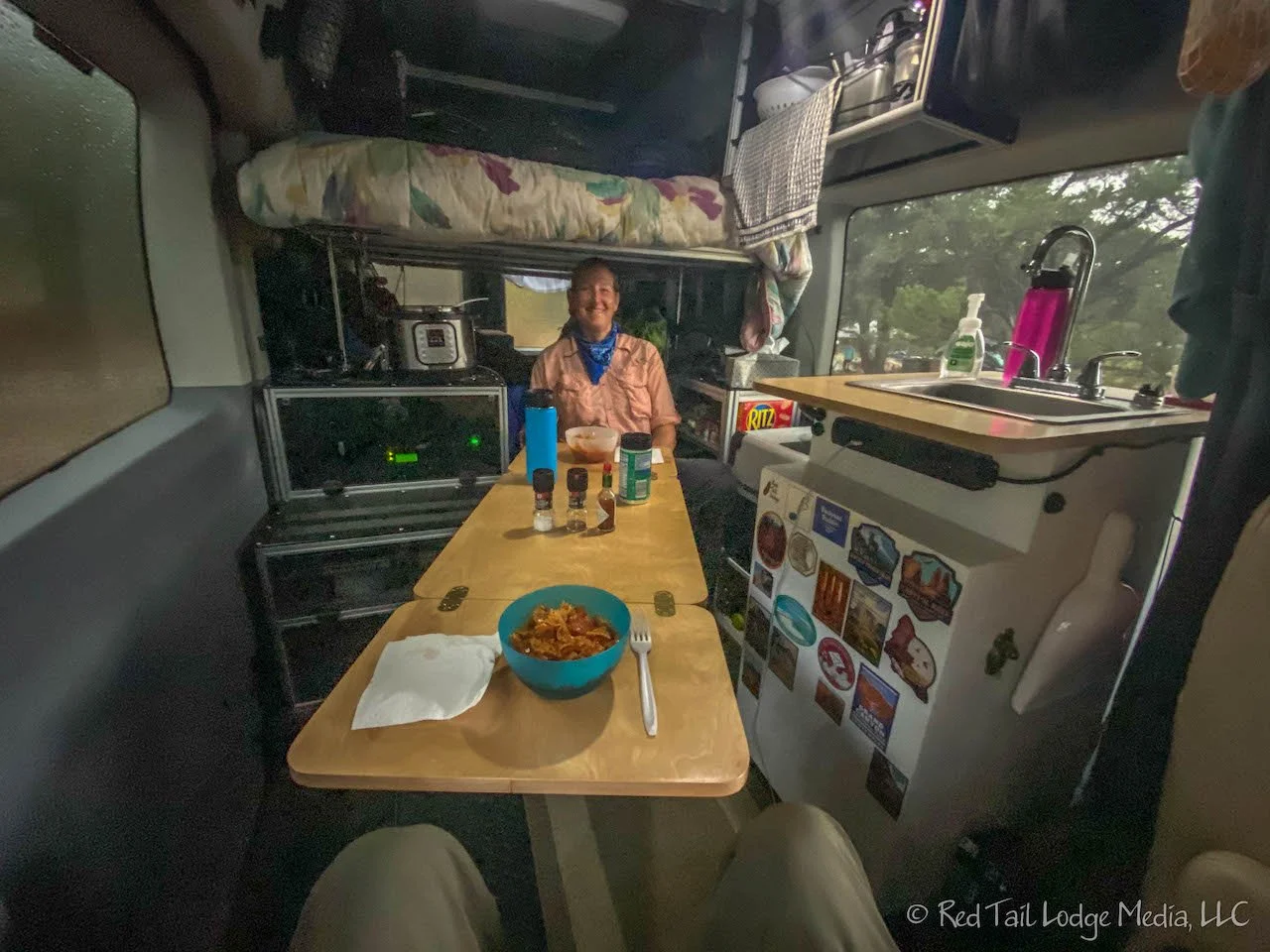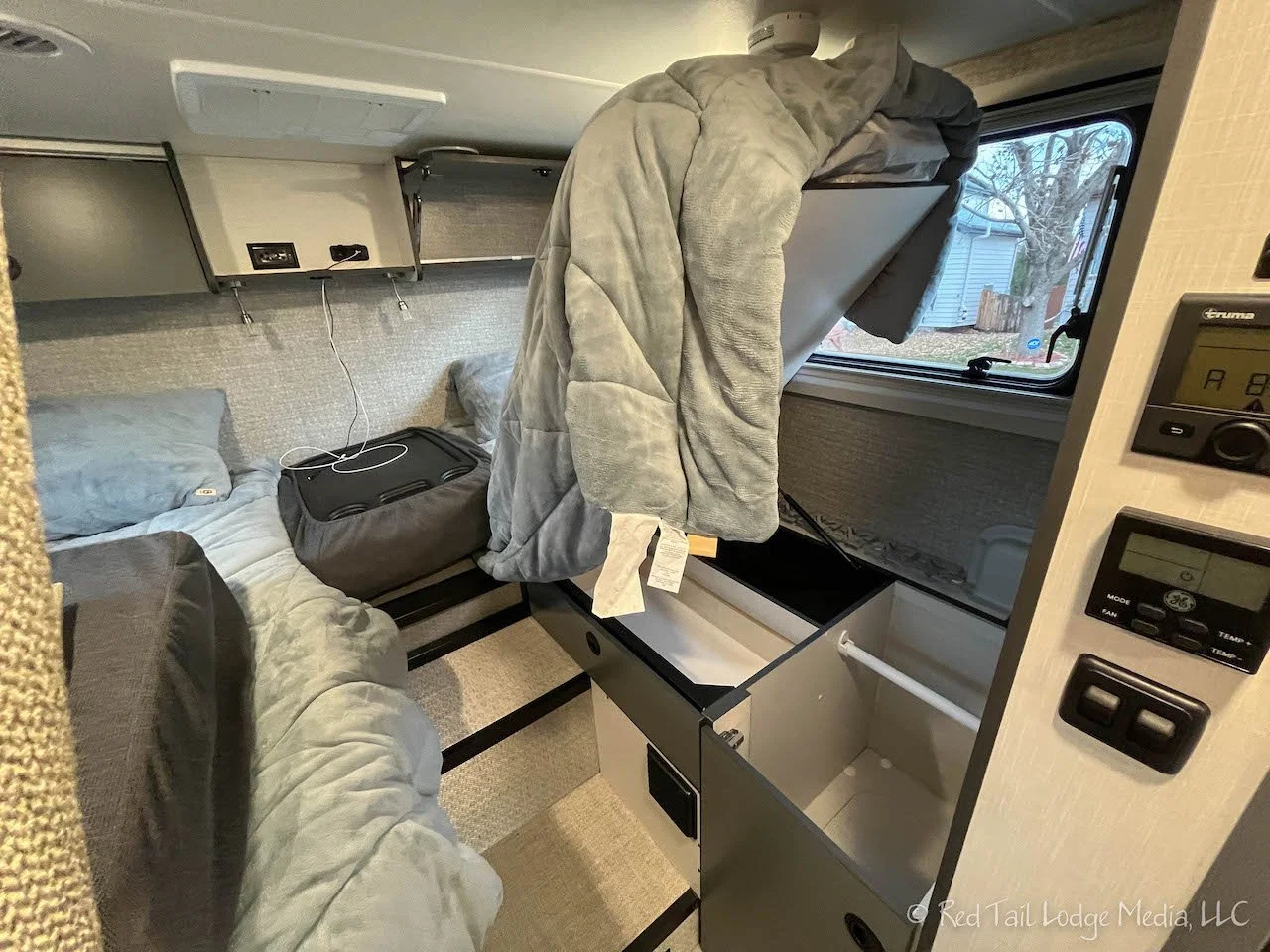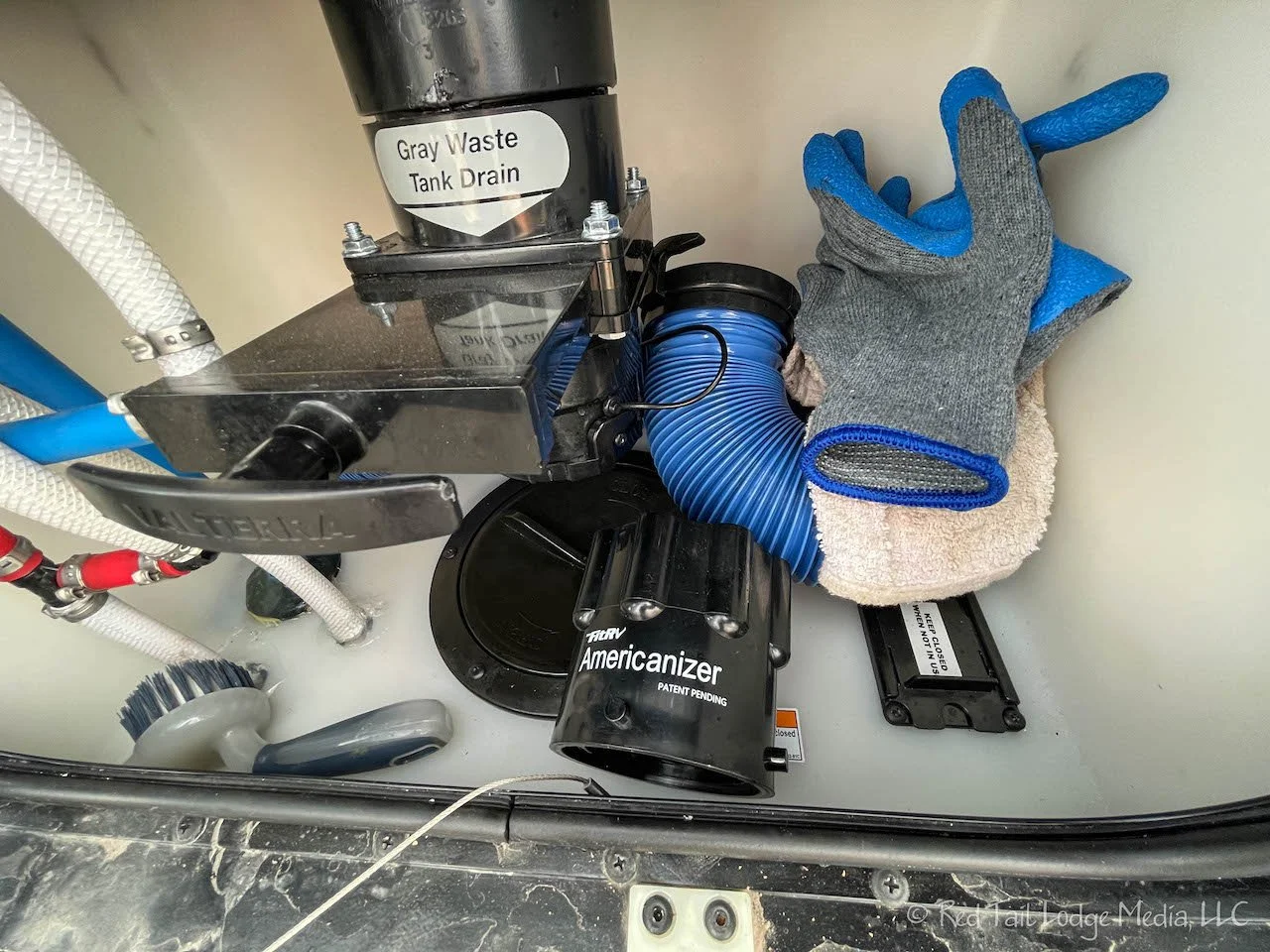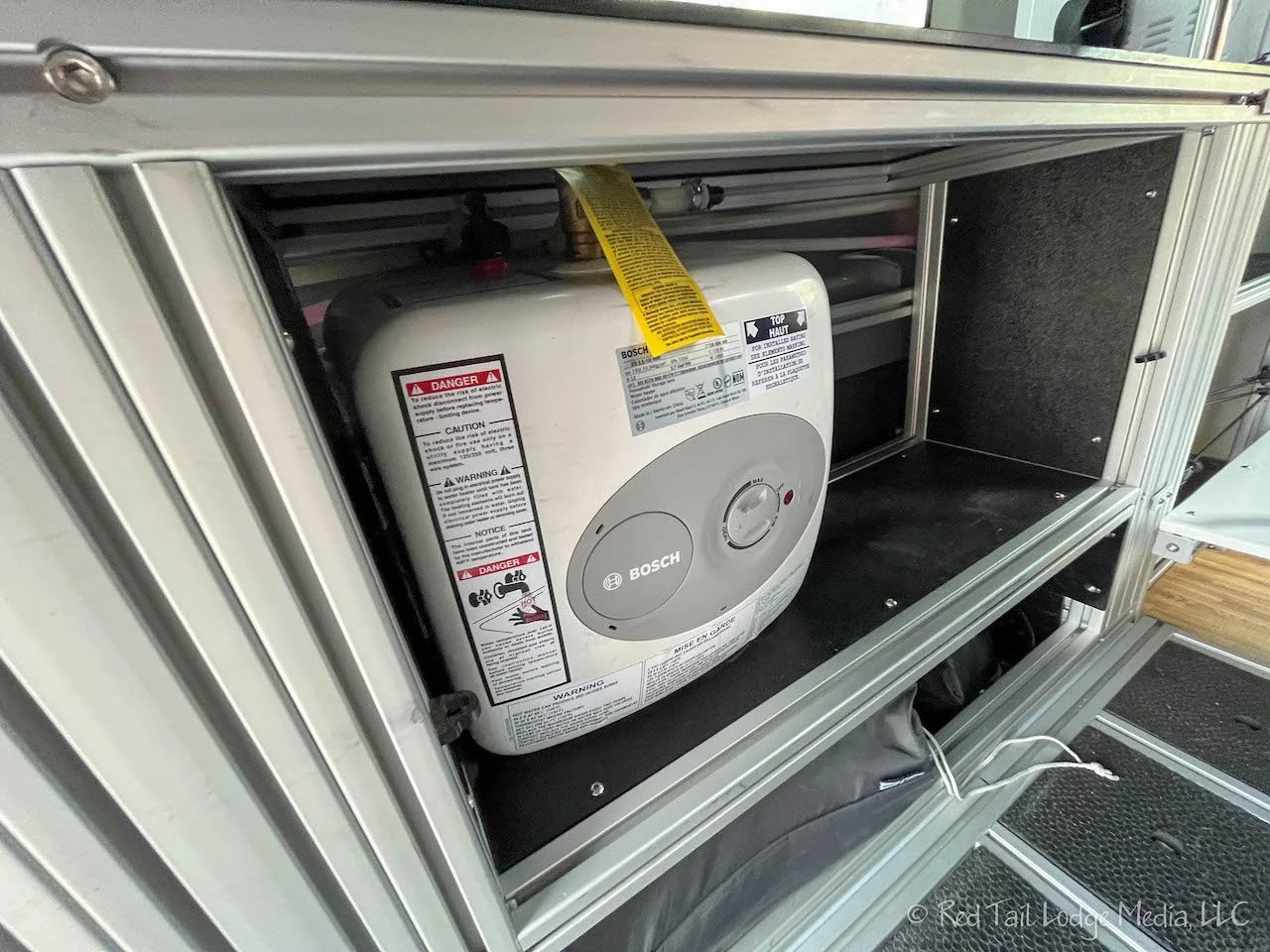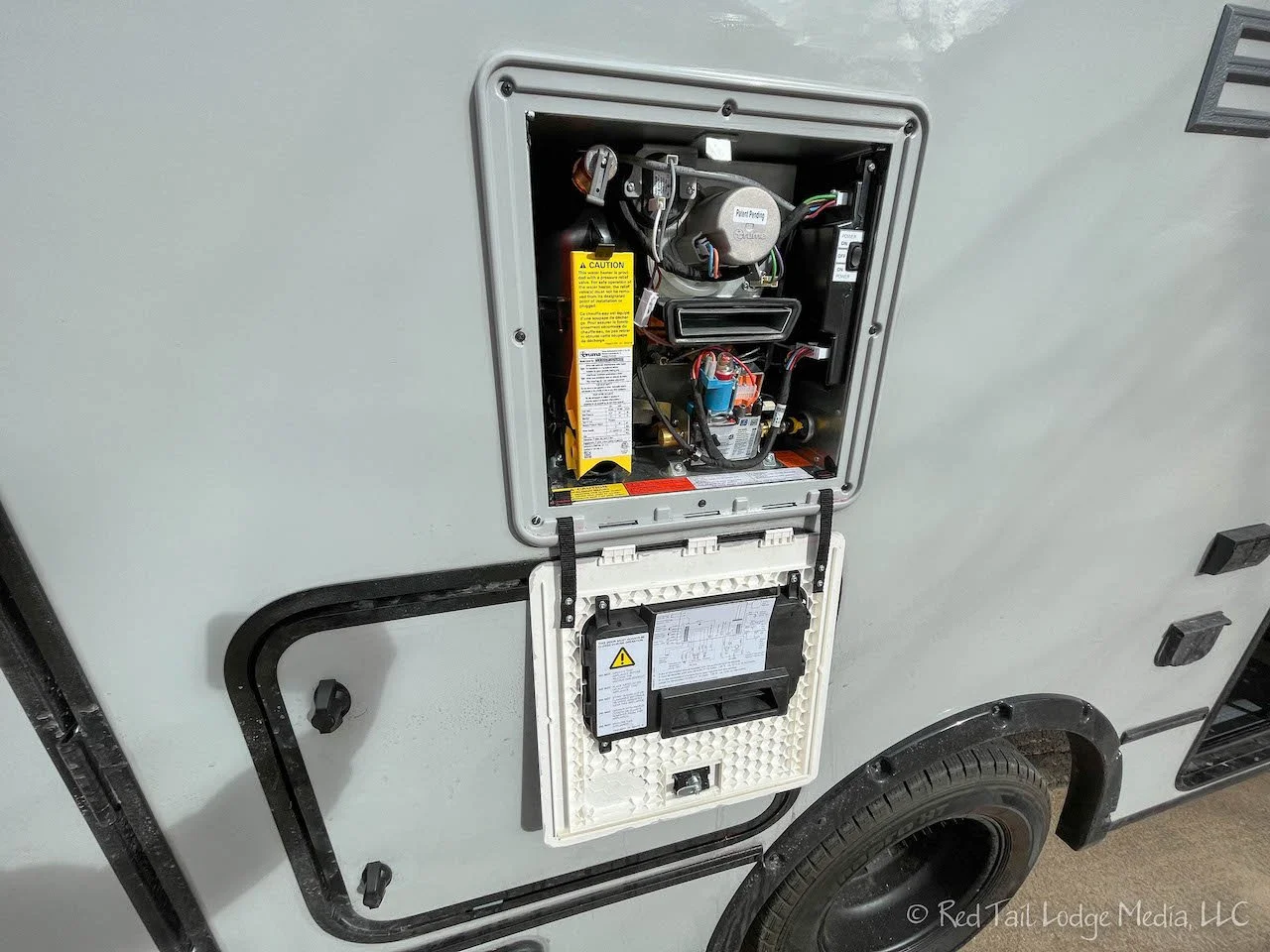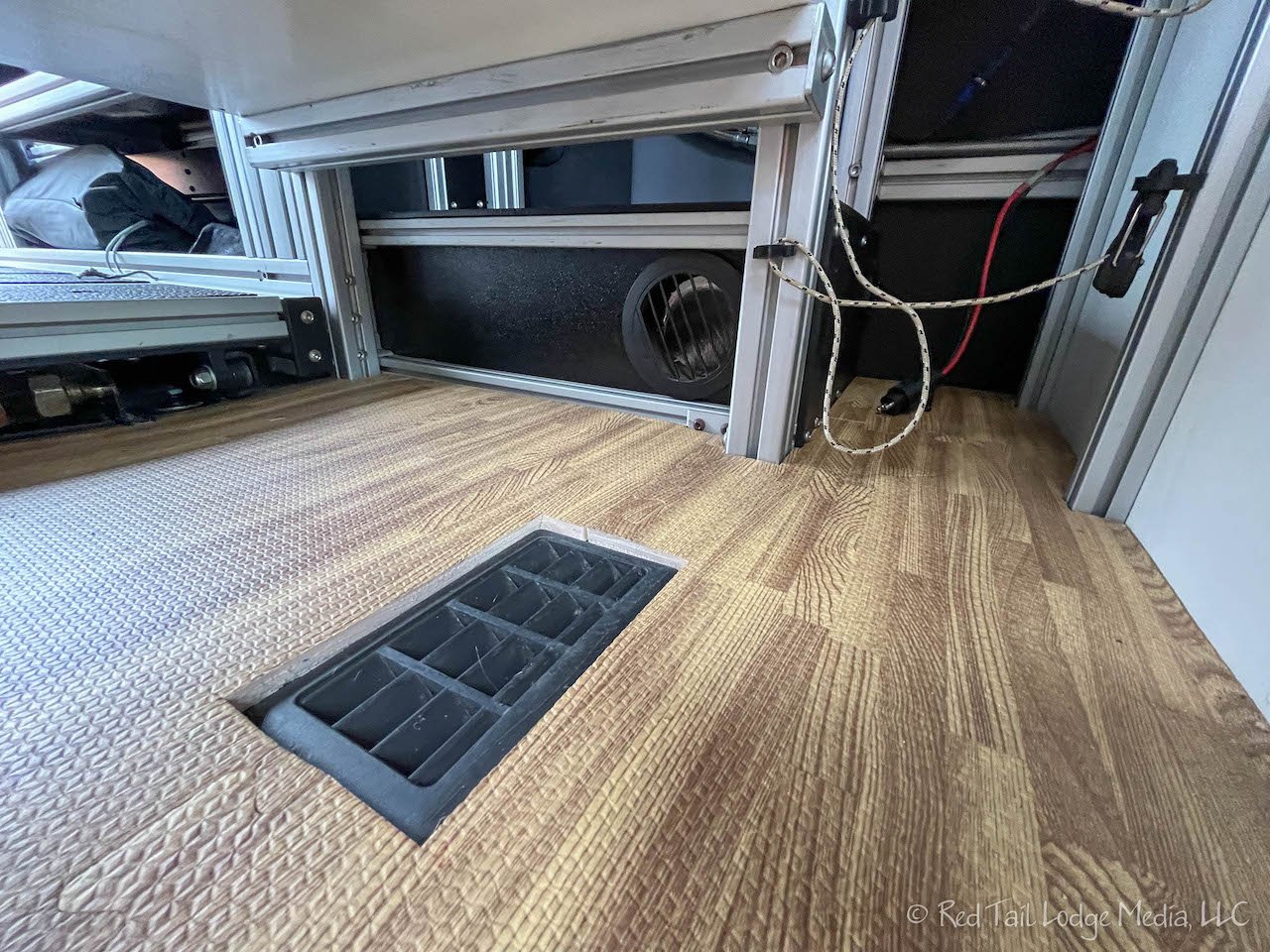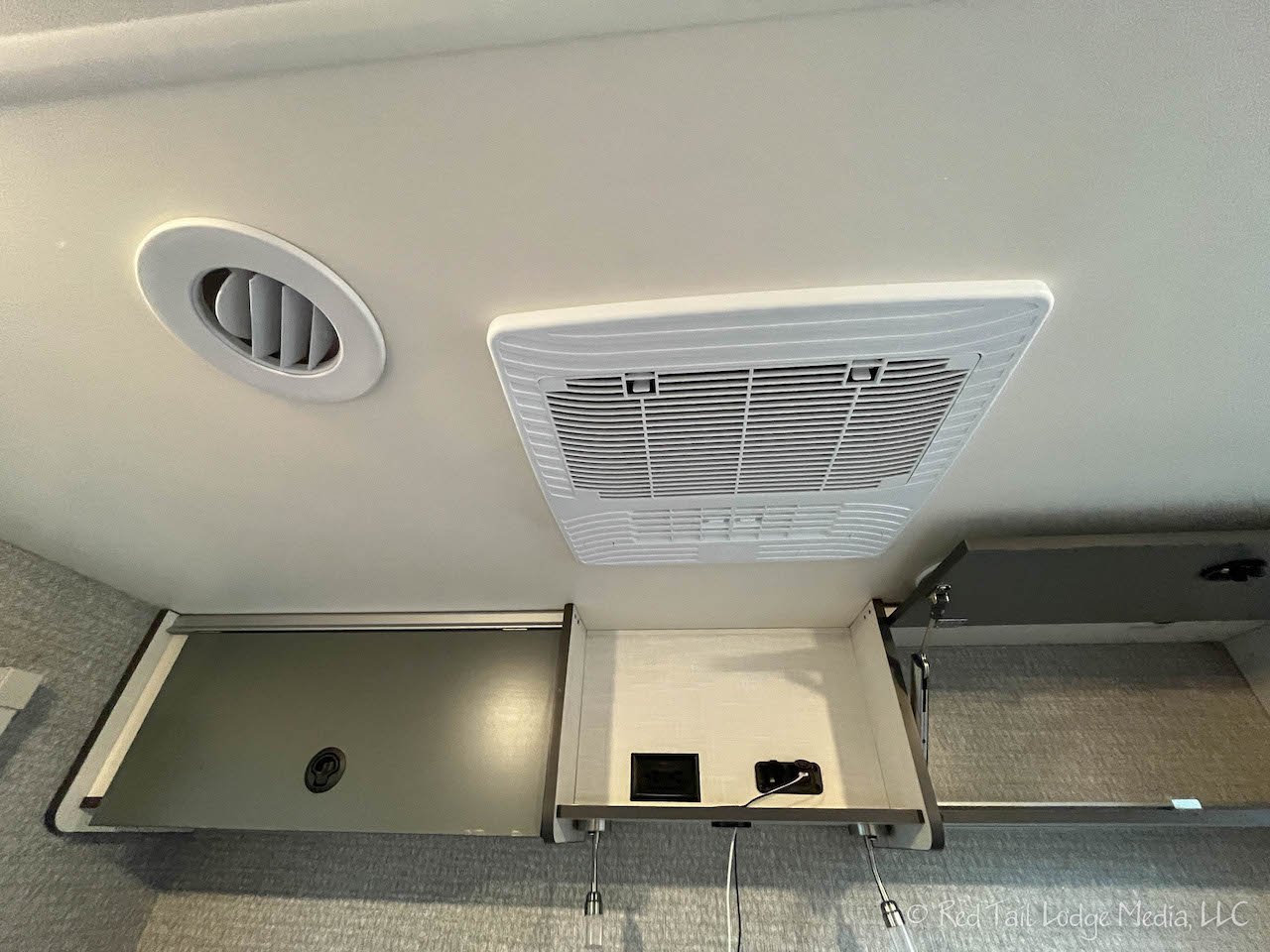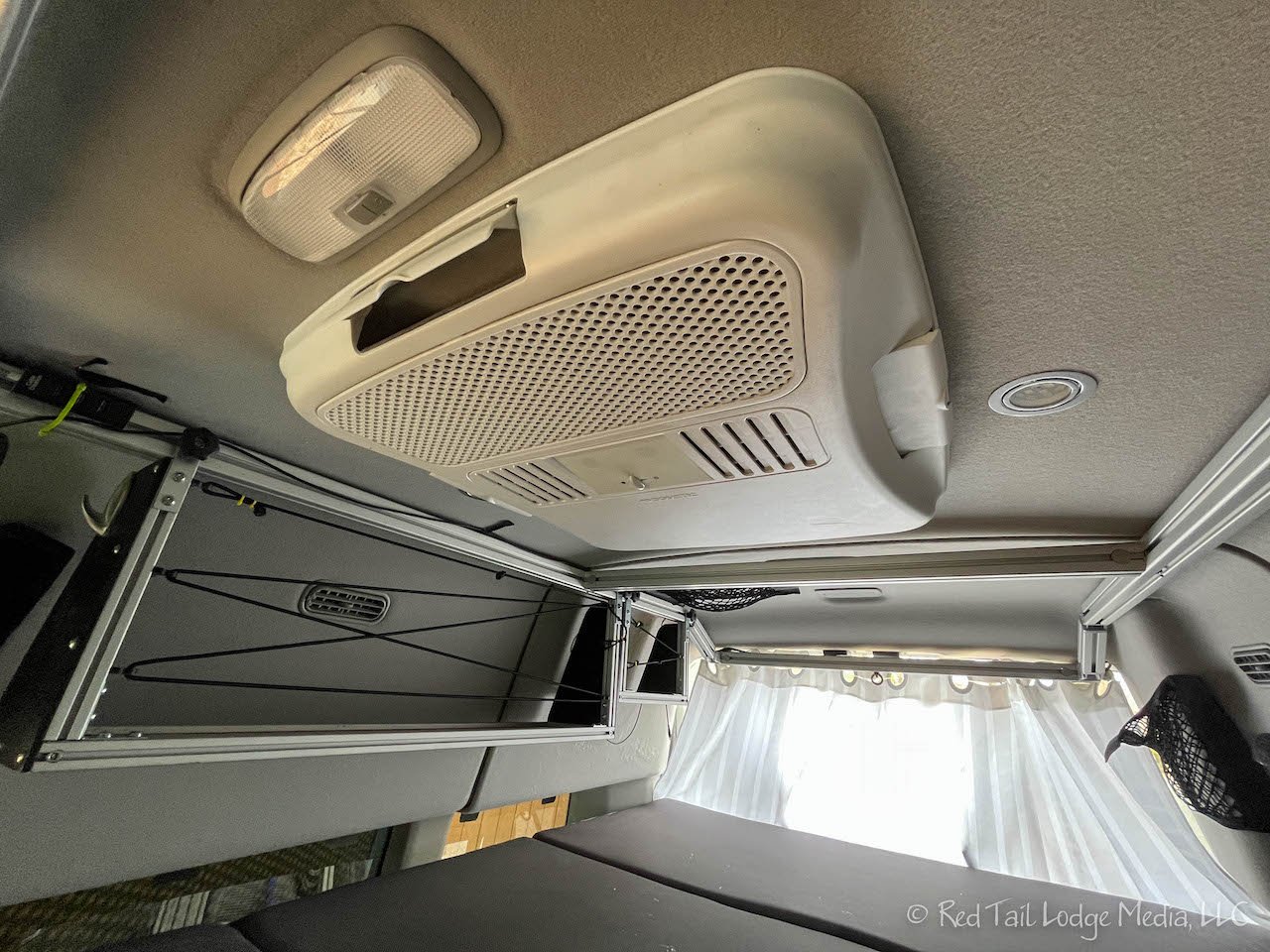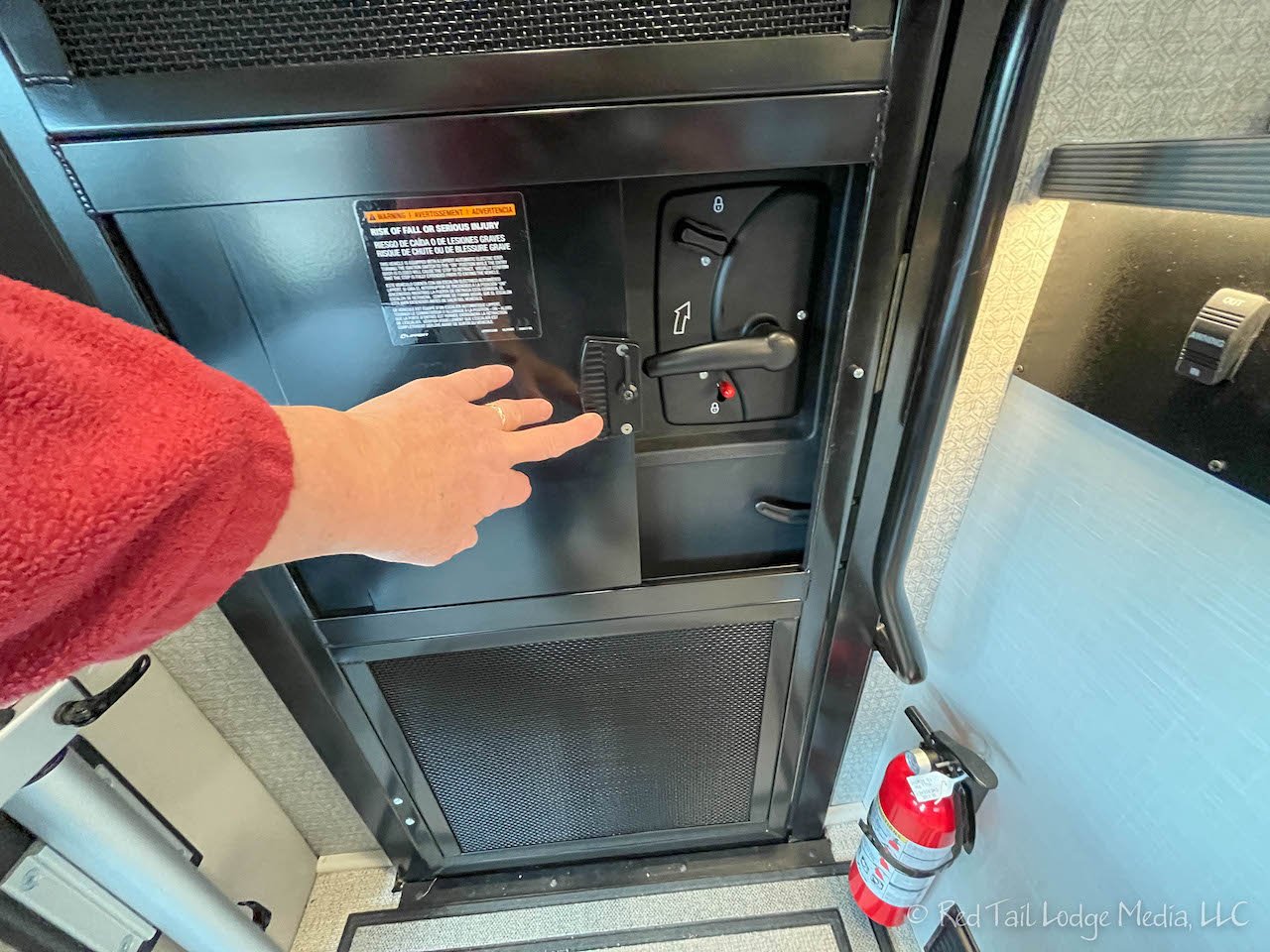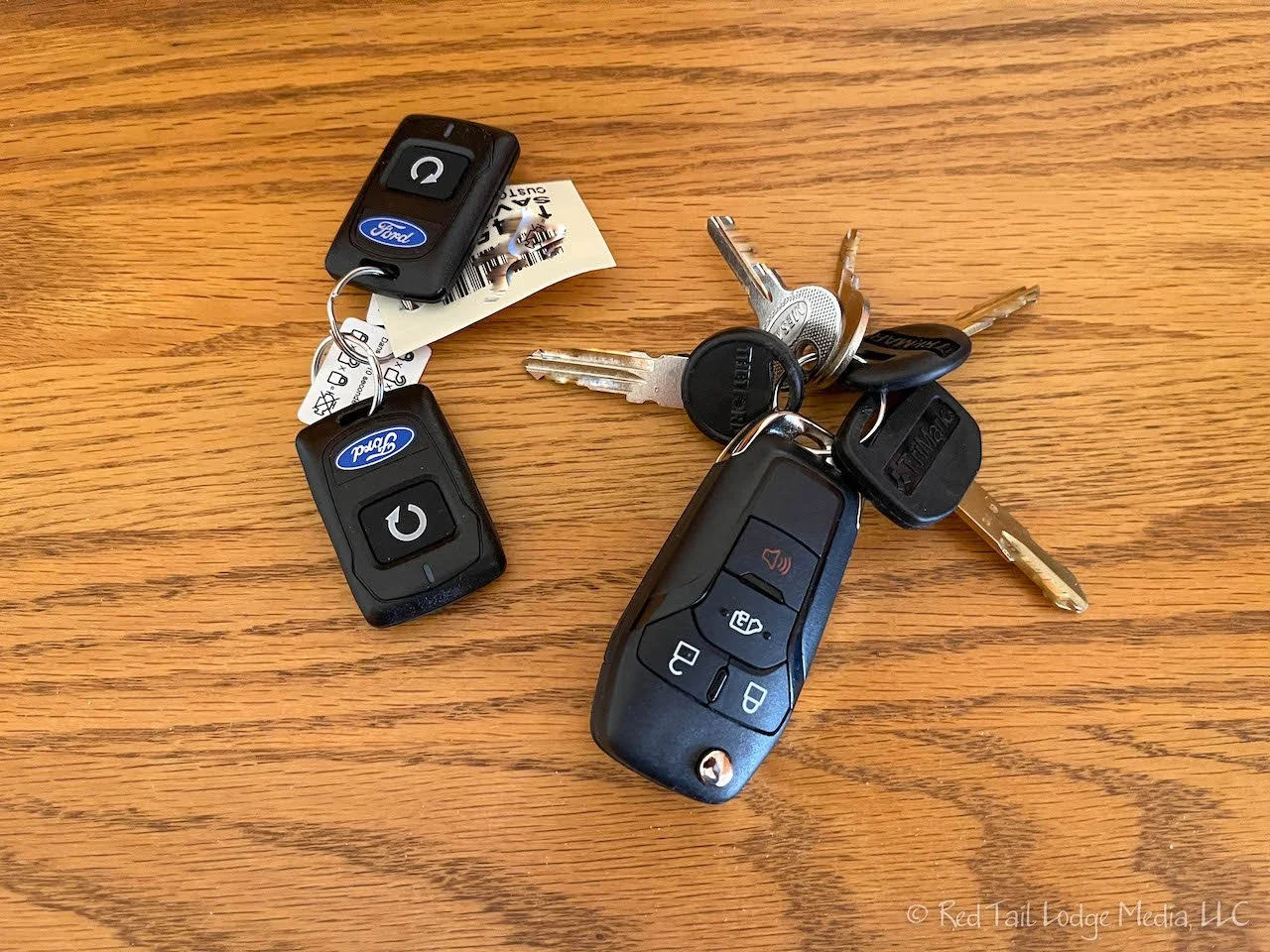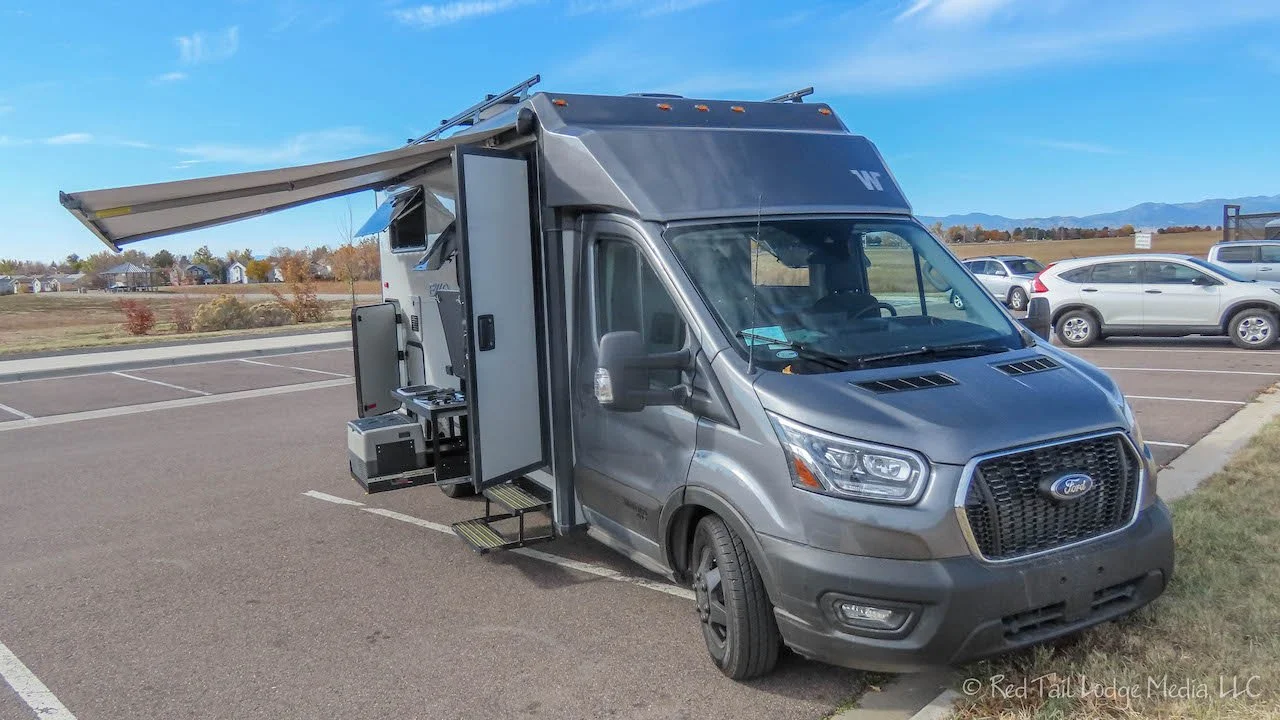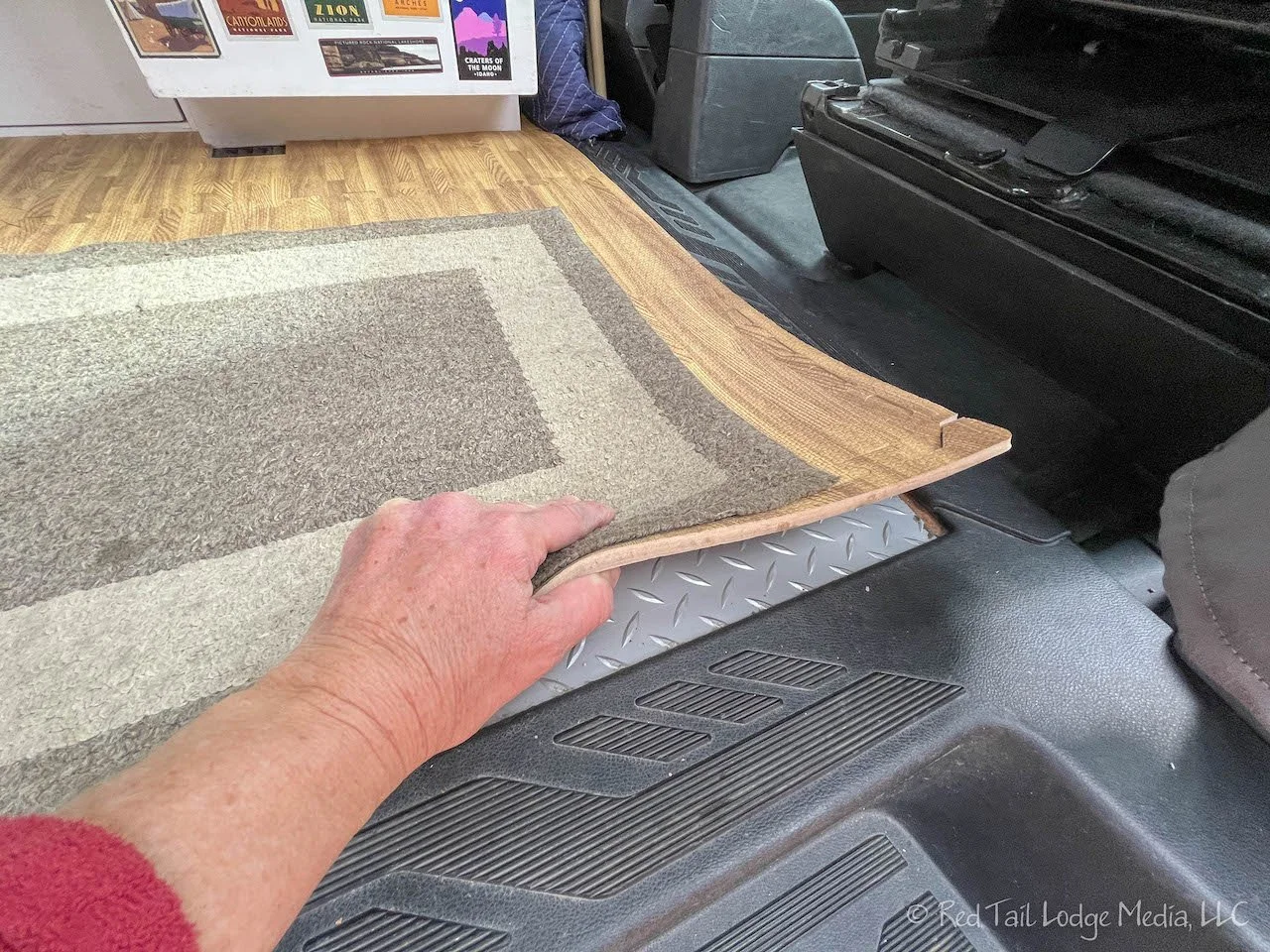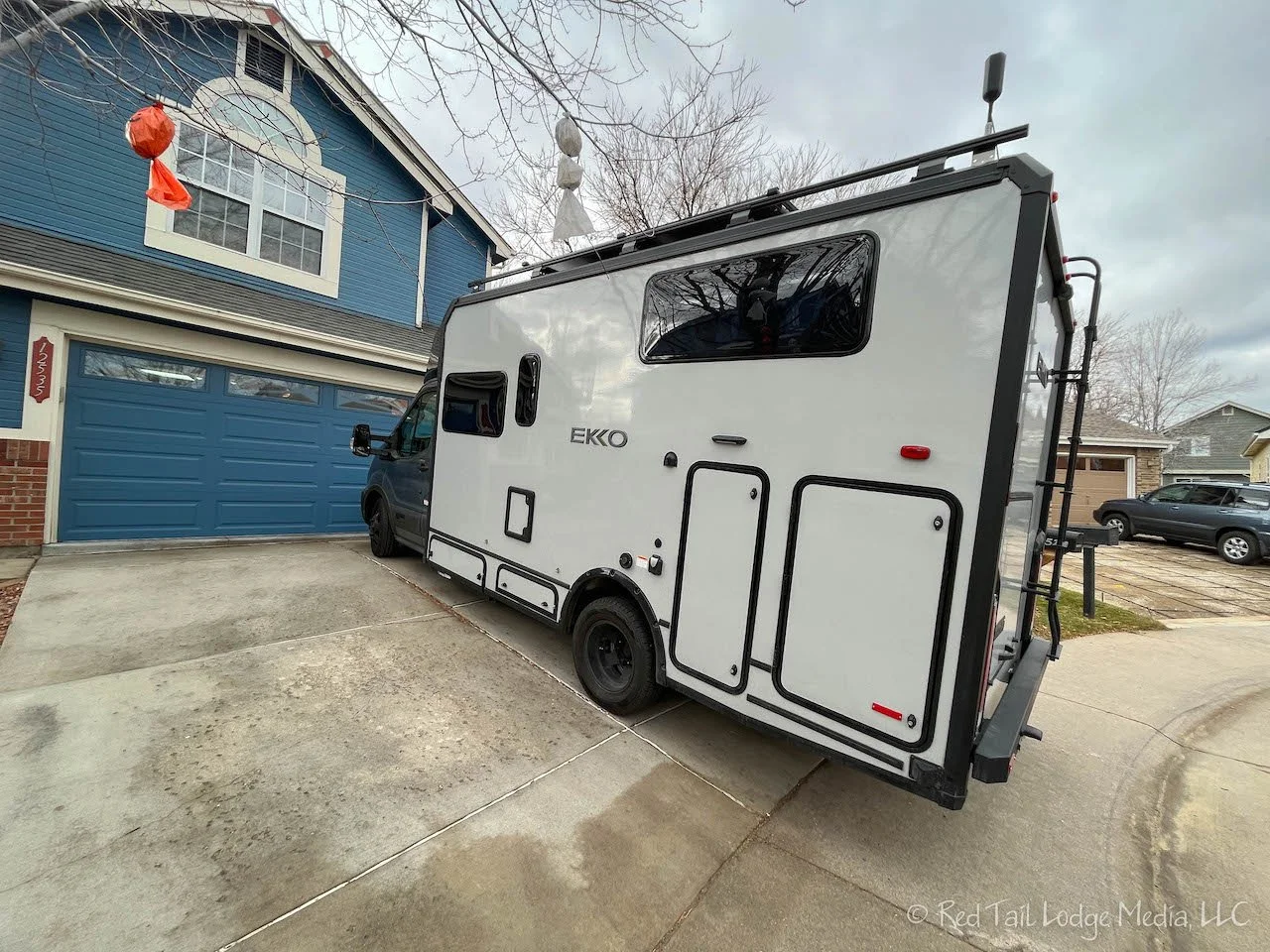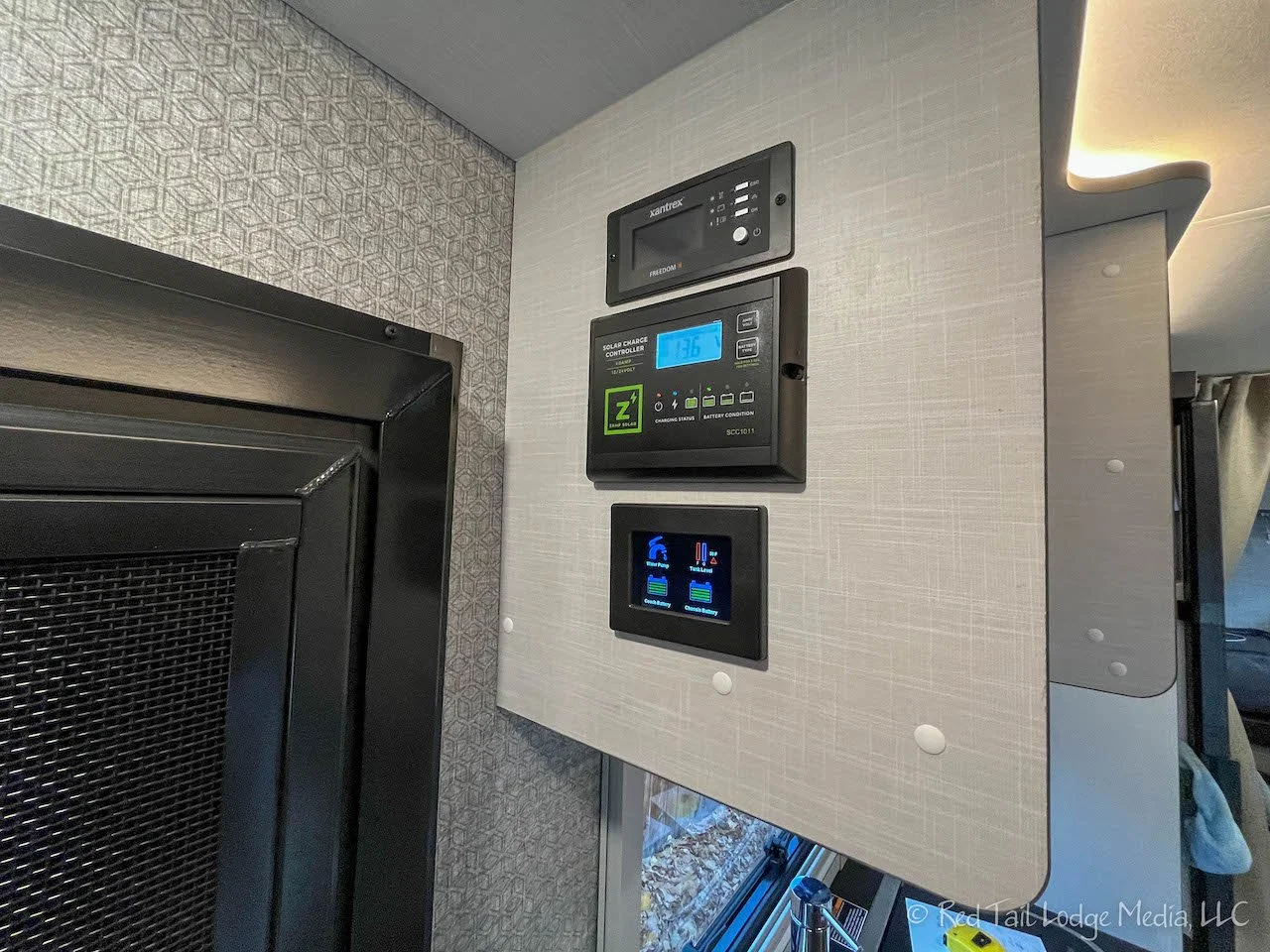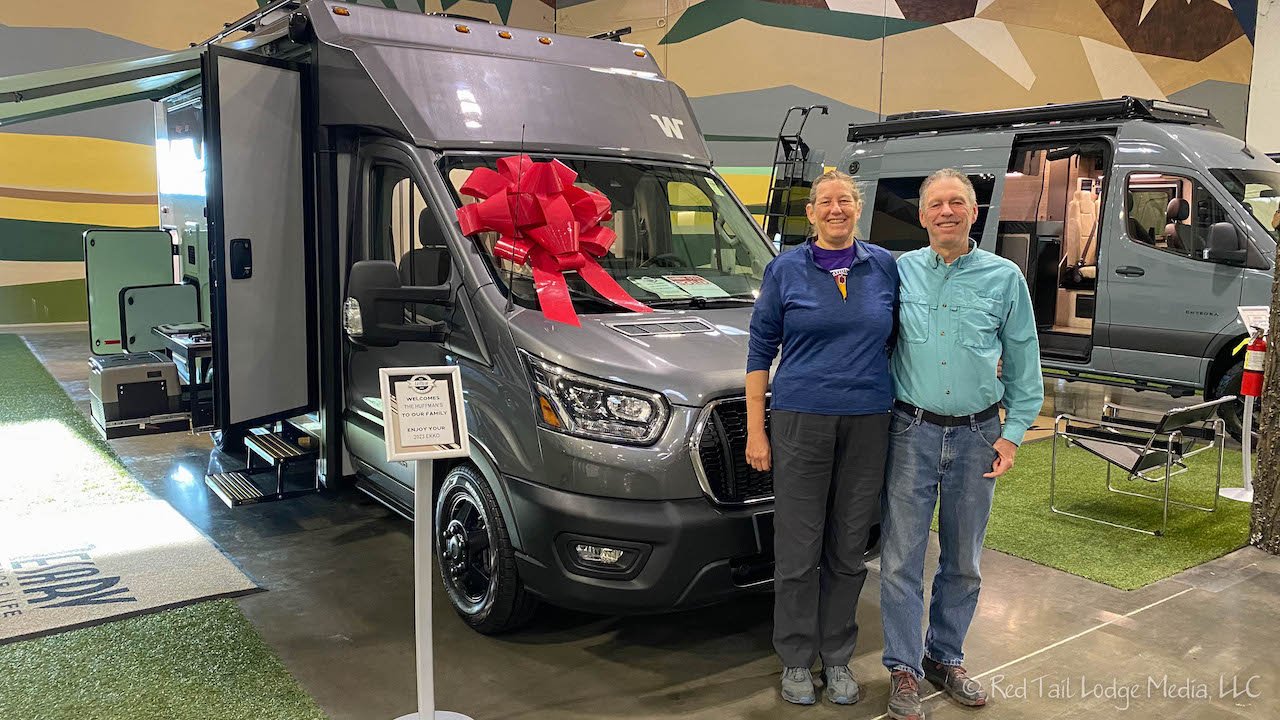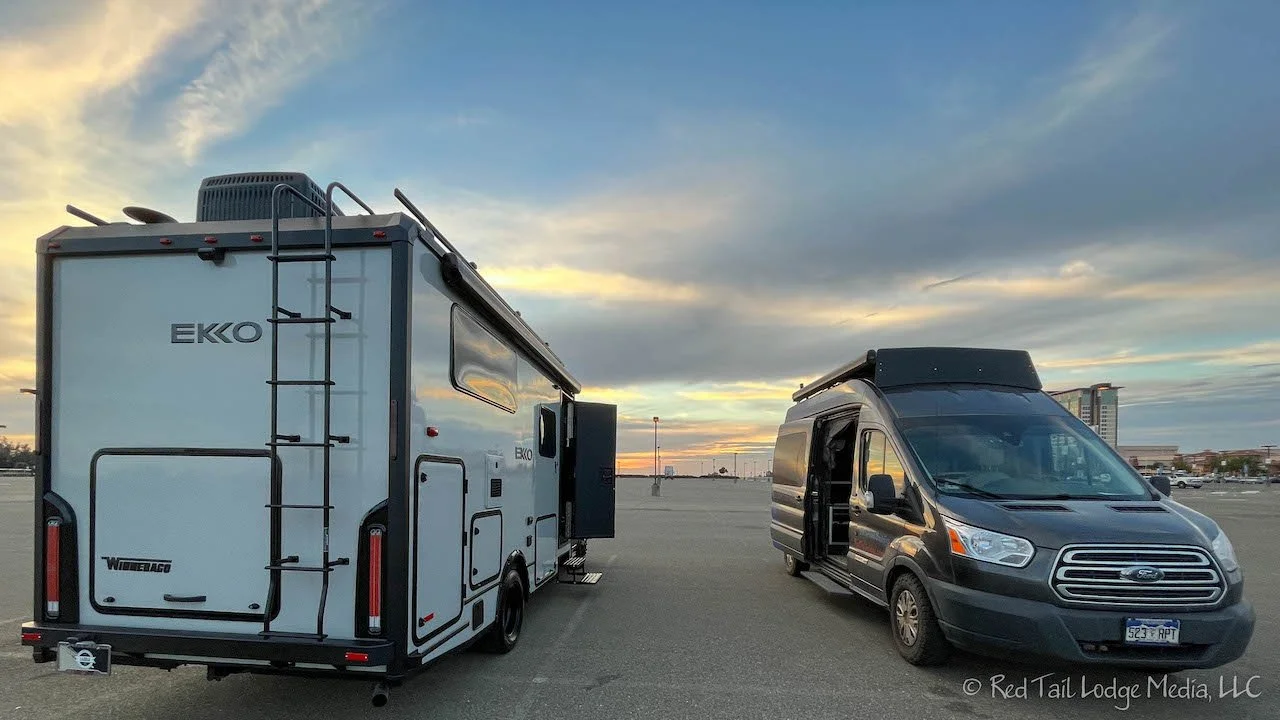Red Tail Lodge (VanDOit) Vs. Red Tail Lodge Two (EKKO)
We thought it would be interesting to do a detailed comparison between Red Tail Lodge (our VanDOit camper van) and Red Tail Lodge Two (our Winnebago EKKO). So here it is. This is not a comparison between all VanDOit camper vans and all EKKOs in general, but just between the particular camper van and EKKO that we have. The items we are comparing are in no particular order.
Class B vs. Class C
Our camper van, like most camper vans, is considered a Class B RV because it is built on a van. The EKKO is considered a Class C because it is built on a cutaway Ford Transit chassis. That means our VanDOit still looks like a van, but the EKKO has a rectangular “box” behind the Ford cab. The walls of the van curve in near the roof while the walls of the EKKO are straight and vertical. So the EKKO has more space near the ceiling compared to the VanDOit and has straighter walls which are easier to work with. However, there are no windows on the back of the EKKO, so the rear view mirror is useless. We liked being able to see out through the back windows of our VanDOit.
2. Ford Transit Chassis
Our camper van was built on a 2018 Ford Transit XLT high roof RWD passenger van with the mid-length and the V8 3.7 liter engine. Our EKKO was built on a 2022 Ford Transit AWD cutaway chassis with extended length, dual rear wheels, and the V6 3.5 liter EcoBoost engine. Because our EKKO is a later model, it has more bells and whistles, like adaptive cruise control, Apple CarPlay, and a larger dashboard monitor screen for accessing controls and viewing the backup camera. The new Ford models also have a parking brake that moves out of the way so the driver seat can swivel in addition to the passenger seat. Even though the engine on the EKKO is smaller (3.5 liters vs. 3.7), we found that the EKKO has more power going up steep hills than our VanDOit, as we experienced on our shakedown trip traveling with both vehicles back from California (Red Tail Lodge Two). We’re hoping the AWD will give us more control when we find ourselves on dirt and gravel while accessing a campground or trailhead. During our shakedown trip, we both felt that the EKKO was easier to handle and felt smoother than driving our van. We ran a little gas mileage experiment during our shakedown trip, since we were traveling the same road, at roughly the same speeds, in the same weather, and alternating drivers. We found that the EKKO, not surprisingly, got a little lower gas mileage. It got 13.2 MPG while the van got 14.4 MPG for the same stretch, a difference of over 1 MPG.
3. Exterior Dimensions
Although the EKKO is slightly longer, wider, and taller than our VanDOit, it is still pretty small and nimble. The EKKO is 23 feet long while our van is a couple of inches under 20 feet. However, when we put our bikes on a rack on the back of van, the two vehicles are pretty comparable in length. Most parking spots are closer to 20 feet in length, but usually we find a spot where we can overhang the back over a curb or borrow some length from an adjacent spot. The EKKO is only five inches wider than the VanDOit (7’ 3” vs. 6’ 10”), so we’re not expecting the width to be much of an issue when parking, although we’ll probably watch out for those side mirrors. Unfortunately, our EKKO has manually folding side mirrors unlike our VanDOit, which had powered folding mirrors. Being able to fold the mirrors came in handy when parking in tight spaces and wanting to keep the mirrors out of the way. Power folding just makes it more convenient. The EKKO also sticks up a little higher than the van. Winnebago lists it as 10’ 6”, but it will be a little higher once we install the weBoost antenna on the roof. Our van, with the weBoost antenna installed, was 9’ 11”.
The height is the most important measurement to remember and we’ll be sure to post it on the windshield by the driver. It’s the height that keeps both vehicles out of most drive thru’s and parking garages and keeps us noting the clearance of underpasses. There will be a few places that the camper van can go that our EKKO will not, but not many. The one place that comes to mind is the Going to the Sun Road in Glacier National Park, which has a vehicle size restriction of 21 feet in max length and 10 feet in max height (in addition to 8 feet in max width).
4. Interior Dimensions
Both the EKKO and our van are built on the Ford Transit high roof. We are both six feet tall and we have ample room inside both vehicles to stand up comfortably. The interior space of the VanDOit is limited by the size of the Ford Transit shell, roughly 76 inches (6’ 4”) tall, by six feet wide (at the widest part), by just over 11 feet long (not including the front cab area). Everything is on the inside and the space can be arranged as you see fit. In our van, the rear of the van is taken up by the lofted queen-sized bed, with a gear slide for storage under the bed. That leaves a small space to live in when not sleeping, about a six foot by six foot area, not including the front cab.
The space inside the EKKO is divided up more. The general “box” interior dimensions are 6’ 8” tall by 6’ 9” wide by 14.5 feet long (not including the front cab area). However, the space is divided among a dinette area, a galley kitchen, a bathroom and a bedroom. In addition, there are several exterior compartments, including a gear garage located below the bedroom.
The interior of the gear garage in the EKKO measures 80.5” long by 29” deep, by 42” high. There is room for two e-bikes in there or our three person inflatable kayak (paid link), but not both at the same time. In comparison, the space under the bed and on the gear slide in our VanDOit measured 64” long, by 45” wide (not including the shelves on both sides of the van), by 41” tall from the top of the gear slide to the bottom of the bed platform, with the bed platform raised to the position we normally kept it in. We easily stored our kayak in there, but we put our bikes on a rack on the outside. The VanDOit van has a gear slide, which makes accessing items under the bed easier. The EKKO has three large doors to access the gear garage, one on each side and one on the back which should make accessing items easy as well.
5. Tank Capacities
The EKKO has larger tanks all around. It has a 31 gallon gas tank compared to our van’s 25 gallons. That should allow us to go further on a tank of gas with the EKKO, despite the lower gas mileage.
The EKKO has a 50 gallon fresh water tank, a 51 gallon gray water tank, and a 5 gallon black tank/cassette toilet. In the van, our fresh and gray water was in 5.5 gallon jerry cans (paid link), as many as we were willing to carry with us. We typically traveled with two fresh water cans and two gray water cans. In addition, we carried two collapsible 5 gallon water containers (paid link), one for fresh and one for gray. That gave us a total of 16 gallons of fresh and 16 gallons of gray water. However, the collapsible containers, which we did use on several occasions, were a pain because we didn’t leave a dedicated space for them when they were full. So when we did fill up one of them with fresh water to get us through a longer stretch, we kept it in our living space while driving and in front of the passenger seat when camped. That meant lifting it every time we setup or broke camp. Water is heavy. Five gallons of water weighs about 40 pounds. We did not have a black tank in the van. On the few occasions we needed a toilet, we used a camping toilet with bags and poo powder (paid link). Since we usually average about five gallons of fresh water per day, the 50 gallon tank on the EKKO should last us about ten days instead of the three or four days of capacity in our VanDOit. That’s assuming our water consumption doesn’t increase due to using the shower that we now have. Time will tell.
The EKKO also has 40 pounds of LP (liquid propane). It is in the convenient 20 pound tanks that, not only can be filled at the same places larger RV propane tanks can be filled, but can also be exchanged at a nearby grocery store or anywhere else they exchange the standard tanks used by many outdoor grills. The EKKO uses propane for the water heater, furnace, and indoor, two burner stove top. In addition, there is a propane quick connect on the outside of the RV to hook up a propane grill or the stove top that comes with the Tailgate Package (outdoor kitchen). Our van did not use propane. The VanDOit water heater runs on AC electricity. The Espar furnace runs on gasoline from the gas tank. When we cooked inside, it was either with the Instant Pot (paid link), electric tea kettle (paid link), or microwave (paid link), all of which run on AC electricity. When we cooked outside, we used a single burner butane camping stove (paid link). That meant we only needed to carry some 8 oz canisters of butane (paid link) with us in the van.
6. Electrical System
<pic of solar panels>
The EKKO has 455 Watts total of solar panels on the roof, which is significantly more than the 340 Watts we had on our van. Our EKKO has the optional second lithium battery, bringing the total up to 640 Amp hours compared with the 315 amp hours of lithium that we had put in our van (Upgrading to Lithium Batteries: Part 1). The batteries in our van would usually last us about two days when there was no sun and we didn’t drive anywhere (so the alternator would not be charging the batteries). So the EKKO batteries should give us enough power for about four days without any sun or running the engine. Both vehicles have a 2000 Watt inverter/charger so we still have to be careful not to run more than one major appliance at the same time, like the microwave, electric tea kettle, and Instant Pot. The EKKO has a Power Share Switch connected to the air conditioner and microwave which turns off the AC while the microwave is on.
7. Bathroom
Our camper van did not have a bathroom, unless you count our emergency camping toilet, which was a folding stool with a hole cut out of the seat where we placed a bag and added a scoop of poo powder. The EKKO not only has a cassette toilet, but it’s in a separate room with a door for privacy. The EKKO bathroom also includes a sink and a shower. Technically, it’s a wet bath because the shower, sink and toilet all share the same floor. However, the sink and toilet stay dry while using the shower due to an innovative wall that swings over to protect the sink, medicine cabinet and toilet while using the shower and swings back when the shower is not in use, hiding the wet walls of the shower.
In addition, both rigs have a spray hose that can be used on the outside of the rig as an outdoor shower or to rinse of items like muddy hiking boots. The outdoor showers can use both hot and cold water.
The disadvantage to having a bathroom is that now we have a bathroom to clean. In addition, there is now a cassette toilet to dump. The cassette is a little easier to dump than a black tank as it can be dumped in an RV dump or a public toilet. Be sure to read the rules of the campgrounds you are staying in, because some do not allow dumping in their toilets. To make it easier to dump the cassette into an RV dump, we purchased the Americanizer (paid link) attachment which allows the cassette to attach to the sewer hose. The Americanizer is a part designed and sold by James of FitRV. Thank you James!
8. Kitchen
The kitchen that we added to our camper van (Item 2 of Preparing Our Camper Van for Season Three 2021) included a sink, counter top and 2.3 cu. ft. fridge. The EKKO kitchen consists of a sink, dual burner propane cook top, and a 5.3 cu. ft. fridge. We’re hoping that more than doubling our fridge capacity will open up more cooking possibilities. We already tested the freezer on our shakedown trip. The freezer passed our “ice cream test”, keeping the half pints of ice cream frozen solid for a couple of days. The tiny freezer in our camper van wasn’t even large enough to hold ice cream. It was only good for making ice cubes or storing a small piece of meat. Even small ice cream novelties would start getting soft after just a couple of hours. The EKKO sink is slightly larger than the sink in our van. The EKKO has very little counter space while the stove top is in use, but there is a Lagun-style table that can be positioned next to the sink for an extra working surface. In addition, the dinette table can be used to stage items while cooking, although it is not at counter height. In our van, there is counter space next to the sink, above our fridge. Our van also had a Lagun table with a custom top (Campervan Project #3: Versatile Lagun Table) that can be expanded out to two feet by four feet. We used our Lagun table as counter space when cooking when we didn’t have the counter next to the sink (Campervan Project #4: Custom Kitchen). After we switched to the larger fridge with the counter next to the sink, we usually left the Lagun table at desk/dining table height and just used it as a staging area, similar to the dinette table in the EKKO. We did not have an indoor stove in our camper van. Cooking inside was limited to our microwave, Instant Pot, and electric tea kettle.
9. Bedroom
The bed in our VanDOit is on top of a platform that raises and lowers manually with hydraulics. Because we usually stored items underneath and we like to be able to see out the back windows while driving, we left the bed up near its highest setting. Even at the lowest setting, we still didn’t have enough room above the bed to be able to sit up in bed. The mattress is a real queen size (60” x 80”). However, where we have the bed positioned, the sides of the van start curving in. So the width feels a little narrower, especially since Keith had hanging shelves on his side to store his clothes. But, the bed is very comfortable. It is perfect if all you are doing is sleeping on it. It definitely is not a space where you would hang out. On the other hand, the bedroom in the EKKO is actually a room. The two twin beds are separated from the rest of the living space with a curtain. Although they are called twin beds, the mattresses are closer to a cot size (30” x 75”) than a twin bed size (38” x 75”) since they measure 32” x 76”. There is also plenty of head room to sit up in bed, especially if you sit facing the rear of the coach. Many people want to sit facing the front of the coach, but we find sitting in the back to be uncomfortable as it requires us to slouch down quite a bit to fit under the overhead cabinets. The EKKO bedroom will definitely be a space we would hang out in. It is also nice to have it in a separate space, so one of us could be sleeping or napping while the other one is up front eating breakfast, having coffee or working on their laptop and not disturbing the sleeper with light or noise.
We find the EKKO beds to be very comfortable. Ann noticed that if she lies on her stomach in bed, the length is a little cramped as her feet hit the wall at the foot of the bed while her head almost touches the back wall. Luckily, we are both side sleepers. If you are six feet or taller, especially if you are a stomach sleeper, you may want to put the two cushions between the beds to increase the width, giving more room to sleep at an angle to give you more length. The extra cushions can also be used to create a queen sized mattress (60” x 80”), sleeping crosswise across the coach. We have not tried this configuration yet. That configuration would make it hard to access the drawers under the beds unless you move the cushions every day. It is also not clear to us how to put sheets on that configuration or how comfortable it would be with the cracks between the cushions beneath you along with not having the “spring” system beneath the extra cushions.
10. Dinette Area
In the camper van, we really only had one living space. It was the dinette, the kitchen, and sometimes the bathroom, but only one of those functions at a time. There were only two comfortable places to sit, one in the passenger seat that was swiveled around and the other on a portable, cushioned seat (Sport-a-Seat - unpaid link) on top of a plywood bench. A person could sit on the step of the electrical cabinet, but it was not very comfortable. Our Lagun table served as a staging area while cooking, a dinette table while eating a meal, and a desk while working or watching videos on our laptop or iPad. If one person needed to use the camping toilet, wash up at the sink, or change clothes, the other person needed to get out of the way and provide some privacy by being up in the bed, in the passenger seat behind the curtains, or leave the van.
In the EKKO, the dinette area is separate from the kitchen, bathroom and bedroom. A dinette table easily flips up into place for use and easily folds down out of the way when not needed or when traveling down the road. There are four comfortable seats. Two of the seats are on a bench seat with three point seatbelts. That means that we can transport two additional adults in the EKKO. The other two seats are the Ford driver and passenger seats which swivel around to face the rear. Since the floor of the living space is a little higher than the floor of the cab, Winnebago provides two booster cushions for the Ford seats to make the height more comfortable. The dinette table is plenty large enough to share a meal on or one person to use as a desk. It is a little cramped for two people to work at the same time. However, the Lagun-style table can be positioned as a desk for a person to use while sitting in the passenger seat. Having four seats also means that we can now have another couple visiting inside with us.
Compared with the camper van, the living spaces within the EKKO seem so spacious. However, our gut feel at this point is that all that living space comes with a price and there is less storage space. It may be just a matter of figuring out where everything goes and using the storage that we have efficiently. We’ll know more when we load up the EKKO for Season Five, so stay tuned.
11. Plumbing
All of the plumbing in both the EKKO and the VanDOit are inside heated spaces, which allows for four season camping. However, in the EKKO, the space is only heated while the furnace is on. Therefore, it is not heated while driving down the road. On our shakedown trip driving back from California, we were in freezing temperatures most of the day on our last day of driving. So we drained the water heater in the EKKO to make sure it didn’t freeze on us. On the other hand, our camper van is built on a passenger van, which means the chassis heat is still operational for the rear. So the whole space inside the van remains heated while we are on the road, thus protecting the plumbing from freezing. Our VanDOit has the additional advantage that the plumbing is more accessible in the event it does need repair.
Since the EKKO has large, built-in fresh and gray water tanks, filling and dumping is a little less flexible. We can no longer carry jerry cans to a small water spigot to fill fresh water or dump our gray water in a toilet or small gray water drain. Water hoses are needed to connect up to a fresh water fill. A sewer hose is needed to empty the gray water into an RV dump. The EKKO is not as flexible or convenient, but the larger tanks means we will be dumping and filling less often.
12. Hot Water and Water Pump
Both rigs have water heaters and water pumps (to maintain pressure in the water pipes). Our VanDOit uses a Bosch Mini-Tank Water Heater (Tronic 3000 T - paid link) which holds 2.5 gallons and runs on AC power. This was plenty of water to do dishes or wash up at the sink, including washing Ann’s long hair. We rarely used the outdoor shower for a shower, so we don’t know how long of a hot shower we would get from 2.5 gallons. The EKKO uses a Truma AquaGo tankless water heater (unpaid link) that runs on propane. It also has a recirculation pump so you can immediately have hot water at the sinks and showers, thus eliminating the need to waste water while waiting for it to heat up.
13. Heating
In our VanDOit, we installed an Espar heater that runs off the gas tank of the van (Espar Heater Installation: Campervan Project #6). It only has one heat vent. We positioned the heater under the bench seat near the middle of the van near the foot of the bed. This keeps the person sitting on the bench seat nice and toasty. Because heat rises, it was always warm in our bed as well. Sometimes it was too warm in the bed. The heater’s thermostat that we have only goes down 57 degrees, which is what we usually set it to at night because it would get warmer than that up in the bed area. However, it would not be as warm in the passenger seat, partly due to being further from the heat source and partly due to the cab not being insulated. Running one or two DC fans, which we have mounted at the foot of our bed, would help circulate the warm air.
The heater in the EKKO is a Trumo VarioHeat furnace (unpaid link) which uses propane. The heat from the furnace is distributed throughout the coach using heat ducts. Not only are there ducts in the bedroom, galley, and dinette areas, there are ducts in some of the exterior compartments, like the gear garage and water control panel.
14. Air Conditioning
Both rigs have a roof top air conditioner. Usually you need to be plugged into shore power to run it. People claim you can run the EKKO AC unit for a couple of hours off the coach batteries, but we do not plan on doing that. Air conditioners use a lot of power and we would rather save our batteries for other uses. If it’s hot, we try to find a campground with electrical hookups. In our camper van, the AC unit is located right above the bed. We try to angle the vents so it is not blowing directly on us while we are sleeping. Opposite of the heat, the person on the bench seat doesn’t get much of the cool air from the AC unit as the bed blocks the air flow and the person in the passenger seat gets more of the effect. Again, the DC fans come in handy and we’ll reposition one to direct the cool air to the person under the bed. In the EKKO, similar to the heat, ducts are used to distribute the cool air throughout the coach. However, unlike the heat, there are no AC ducts leading to the exterior compartments.
15. Entry Door
Our camper van has, well, a sliding van door that came with the Ford Transit. Ours was manual, not powered. That means you have to somewhat slam it to get it to close properly. It also has a running board, which, unlike the door, is powered. So the running board extends out when the door is opened and retracts when the door is closed. The door is a little heavy, so opening and closing it when parked on a steep slope can almost be dangerous and care must be taken to keep body appendages out of the way. Although it is nice to have such a large opening to allow for ventilation and getting large items in or out of the van, it can be rather noisy. We try to limit how many times we open and close it late at night and early in the morning so as not to disturb neighboring campers.
The EKKO has a more traditional RV entry door. It is actually two doors. There is an outside, solid door and an inner, heavy duty screen door. Opening and closing the outer door extends and retracts steps. However, there is a switch which allows the steps to stay extended regardless of the door’s position. Getting in and out of the rig through the entry door is much quieter than the van. However, to us, it seems more complicated than it needs to be. The outer door isn’t too bad, except that it has two separate key locks on it, each with a different key. The complication seems to be more with the screen door. The handle to open and close the screen door is only on the outside of the door. When you are inside the rig, with just the screen door closed, you need to slide open a small pass through to reach the screen door handle. If you have both doors closed, you first slide open the pass through (or leave the pass through open), use the screen door handle to release the screen door, then turn the outer door handle to open both doors. There are magnets that keep the screen door attached to the outer door, but only if you release the screen door first. If you turn the outer door handle before the screen door handle, then the two doors swing separately. The screen door also has a lock with, you guessed it, another, different key.
While we’re on the subject of keys, we should mention that there are three more keys for the EKKO. One is the Ford Transit key which opens the driver and passenger doors and starts the engine. Then there is a key for most of the exterior compartments except the compartment for the toilet cassette, which has its own separate key. We wouldn’t want someone to steal our poop! There is also a remote start fob. So, for one vehicle, we have seven items on our key chain. In comparison, our van has, well, just one key, and we didn’t even it use it half the time since we had a keypad installed which unlocks all the doors on the van. OK, to be fair, we sometimes had two other keys with us in the van, one for the swing away hitch (unpaid link) and one for our bike rack. But, if we take e-bikes with us in the EKKO, we’ll have two e-bike keys, one for each bike.
16. Windows
Since our VanDOit van was built on a passenger van, there are windows all around the vehicle. However, the only two that open are the ones in the front driver and passenger doors. For ventilation, we used Ford Transit Van Cab Window Air Vent inserts (unpaid link). For even more ventilation, we would leave the sliding door open and/or the rear doors open, as we had screens covering both openings (Item 15 of Preparing Our Camper Van for Season Three 2021). However, we did not feel comfortable leaving the doors open at night while we slept. For privacy, insulation, and blocking out light, we used VanDOit shades for all of the windows.
In contrast, the EKKO has double pane acrylic windows that all swing open, awning style. There is a large window in the kitchen/galley with another large window across from it by the dinette, providing nice views and cross ventilation. There are two smaller windows in the bedroom, across from each other, again providing nice cross ventilation. There is even a small window in the bathroom, which will probably come in handy to let potential odors or humidity escape. Each window has a screen and shade that can be raised or lowered into place. You can also have the shade cover just part of the window with the screen covering the rest of it. In addition, the windows can be cracked open and locked at the same time. That will come in handy when we want to keep the coach secure with some ventilation.
To shade the windshield and windows in the cab, Winnebago provides a curtain that hangs up forward of the seats, attaching with buttons of velcro. We are not impressed with this curtain, as it doesn’t fit very tight, sagging on the sides, and not providing complete privacy. We have already ordered shades from Vanmade Gear (unpaid link) for the windshield, front door windows, and the ceiling fan.
With the abundance of windows and the nice placement of them in the EKKO, we should not need the front window vents that we used in the van nor any additional fans, other than the provided MaxxAir ceiling fan.
17. Fans
Both our rigs came with a MaxxAir ceiling fan. The one in our van is bi-directional while the one in the EKKO only blows air out. To be fair, we always ran the fan directing the air out of the van. They both have multiple speeds. In addition, you can just hand crank the dome open to allow air to vent without turning the fan on. This is nice is cold weather when you want to vent rather slowly so you don’t loose as much heat or drain the batteries. The one in our van has a rain sensor so that it closes automatically when it rains. The fan in our van rarely closed automatically because it sits under our solar panels, so it had to be pretty windy for the rain to come in through the fan. The fan in our EKKO does not have a rain sensor, but it has a rain shield. Since it is not located beneath any solar panels, we’ll keep an eye on this to see how well the rain shield keeps the water out. The fan in the EKKO does have an automatic setting where it will turn on if the temperature inside the coach reaches 78 degrees. Having a ceiling fan in a rig is a must. It helps increase air circulation, pull in fresh air, and exhausting humidity, odors, and fumes. This will be especially important in the EKKO when cooking with the propane stove top.
In our VanDOit van, we also had two small DC fans. We mentioned before that we used them to help distribute heat and cool air around the living space. We also used them to blow air directly on us while we slept when it was hot and we didn’t have electrical hookups to run the air conditioner. With the ducted heat and ducted air conditioner in the EKKO, along with windows that provide cross ventilation, we do not foresee a need to have any additional fans other than the MaxxAir ceiling fan. Time will tell.
18. Awning
Awnings are a mixed bag for RV’s. On the one hand, it’s convenient to put out when you need some shade or protection from a light rain. However, they usually don’t do well in wind and the rig might be in the wrong position relative to the sun to provide any actual shade. It’s also not good to put them away wet. Both of our rigs came with a Carefree powered awning. The one on our van has two support legs. We broke the plastic locking lever on both of the legs, but they were easy to replace with new parts from Carefree. We also had to repair the awning when we sheared off a couple of the mounting bolts when a dust devil came through the campground (Buena Vista Ghost Towns - August 7th to 10th, 2020). We’re just thankful that Keith was there to grab the awning and prevent it from being carried off. We also carried a Moon Shade (unpaid link) with us, which is helpful for providing shade on the other side of the van and does a little better in the wind. The Carefree awning on the EKKO comes with a wind sensor and will retract automatically when it senses too strong of a wind. It also has no supporting legs. Our original EKKO order included the Batwing manual awning option, but it was not part of the EKKO we ended up purchasing. We’re hoping we can order a Batwing and have it installed at a later date. In the meantime, we plan on taking the Moon Shade with us again. Shade is nice not only to sit in and cook in, but shading the vehicle also helps keep the inside of the rig cooler.
19. Breaking Camp
What we loved about our VanDOit camper van was being able to break camp in about five minutes. We’re hoping packing up the EKKO doesn’t take much longer. For the camper van, the main items to take care of were putting up the gear net across the top of the bed (to keep items we stored on the bed including the mattress from flying off when breaking hard), turning off/closing the ceiling fan, taking out the window vents from the front doors, turning off the air conditioner or furnace, storing the window shades, removing and storing the leveling blocks, unplugging from shore power, putting the awning in, locking the drawer and cabinet door on the kitchen pod, and doing a walk around. In the EKKO, there are a few more items to check when packing up. There are a lot more cabinet doors and drawers to check for being secured, a lot of windows to close, an entry door to lock, a step to retract, propane to turn off, and a bunch of exterior compartment doors to lock. We’ll see how much extra time that takes us.
The amount of time it takes to pack up is important when traveling with a Class B or Class C RV because, not only do you need to pack up when you change camping sites, you also have to pack up when you want to go anywhere that is too far to walk or ride a bike to. We’re hoping that traveling with e-bikes will increase our biking range and reduce the amount of times we need to pack up our rig.
20. Tires
Both have a full sized spare. The EKKO is a dually, which means there are six tires to maintain and replace instead of four. The dually also requires more leveling blocks, since you have to raise up the dual tires the same amount at the same time. In addition, we needed to replace our air compressor with one that had a longer wand to reach the stem valves of the inner tires. We’ve never owned a dually vehicle before, so there may be more things to learn that we haven’t discovered yet.
21. Insulation
Both rigs are well insulated. The VanDOit window shades used in our camper van provide some insulation for the windows. We’re not sure how much insulation the shades in the EKKO provides, but the dual pane acrylic windows should help with heat transfer through the windows. The Ford cab itself is not insulated. In the van, we had heavy curtains that we could close which isolated the living space from the cab (Campervan Project #5: Shades and Curtains). In the EKKO, Winnebago provides a heavy insulating curtain that snaps into place between the cab and the dinette. It has a long zipper in the middle, running the length of the curtain, making it easy to access the cab if you need to grab something. We will be keeping this curtain, although we might consider rigging something up so we can keep it in place and just pull it back with ties, to make it as easy to use as the curtains we had in the van. We’ll see.
We don’t remember feeling any cold drafts in either rig (except for the front cab). In the EKKO, the wall next to the bed on the driver’s side was cold to the touch during our cold shakedown trip. However, Ann stayed warm during the night as long as she didn’t come in contact with the wall. We also noticed the floor of the EKKO was cold on our bare feet during our trip back home. We’ll probably be adding some rugs for added warm on our feet. In the camper van, we had foam flooring in the living area which kept the floor warm (Item 9 of Preparing for Season Four: Alaska Bound 2022).
22. Modularity and Flexibility
This is where our VanDOit camper van shines. T-track (or 80/20 - unpaid link) is used everywhere, which allows for different configurations and makes modification and rearranging things easy. Even the kitchen pod we made was secured in the van to a T-track on the side wall. During the summer, our van was a camper van for our travels. In the winter, when we were home, it took us about 30 minutes to remove the kitchen pod, the plywood bench seat and a couple of shelves. Then we re-installed the two rows of the Ford bench seats, turning our van back into a six passenger van. Or we took the bench seats out so we could haul building or landscaping materials for our home projects. The gear slide came in handy for getting large items in and out of the van. The van was our only vehicle. It was our daily driver when we were home.
The EKKO is not modular nor flexible in the same way. We can make modifications to it, but they are of a more permanent type. The EKKO is also just a little too long to fit in our short driveway, so we will be putting it in storage while we are home. That also means we need to purchase another vehicle for driving around town while the EKKO is in storage. Ka-ching, ka-ching!
23. Complexity
As you could probably already guess from the discussions above, the EKKO is much more complex than our VanDOit camper van. We’re glad we started with the camper van. If the EKKO was our first camper/RV purchase, all the of unfamiliar systems might have been a little overwhelming. However, most of the systems are now familiar to us, so they are not intimidating. More of the systems are visible in the camper van so we can see how they work. In the EKKO, most of the systems are hidden behind walls, making them a little bit more of a mystery. In the camper van, we had control panels for the furnace, air conditioner, solar controller, and inverter/charger along with multiple switches for the water pump and a remote switch for the water heater. Since we had installed/reinstalled about half of them ourselves, we understood them. Similar panels exist in the EKKO. The control panel for the water heater and furnace, along with another one for the air conditioner are located in the hallway near the bedroom. The control panels for the inverter/charger, solar controller, and water pump/tank level monitors are located next to the entry door. Although the details of these panels are different from the ones we had in the van, the concepts are still the same. The main system in the EKKO that we didn’t have in our van is the propane.
24. Price
The price of our EKKO was about twice as much as we paid for our initial VanDOit camper van four years ago. That is not including the cost of the modifications we made to our van ourselves over the years, like making our own kitchen pod, switching to a larger fridge, installing the Espar furnace, and upgrading the AGM batteries to lithium. Our camper van was built on a one-year-old used Ford Transit, not a new one, which also saved us money. If you were to purchase an EKKO and a similar VanDOit on a new Ford Transit with the extended length, AWD, with dual wheels, the price difference would not be as great.
Conclusion
So there you have it. In our minds, there is no clear winner between the two. They are both great rigs. The one that may be the best for you depends on your priorities and how you like to travel. If the EKKO existed four years ago when we bought our VanDOit, we would have still bought the VanDOit van because it was what we needed, wanted, and could afford at the time. However, now that we have more finances available and are looking for a little more comfort, the EKKO is the better fit for us today.
For up-to-date information on our rigs, go to Our Rig page.
Check out our related video: VanDOit vs EKKO
(Ann)



